


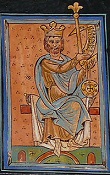
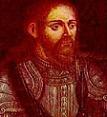










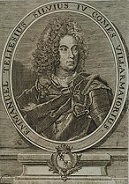
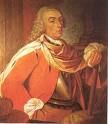
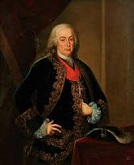


















TLW's Portugalscope™ (Portugal Historyscope) |
By T.L. Winslow (TLW), the Historyscoper™ |
© Copyright by T.L. Winslow. All Rights Reserved. |
Original Pub. Date: July 14, 2017. Last Update: Oct. 27, 2022. |
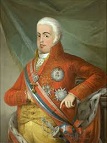

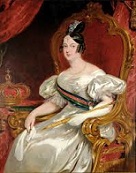

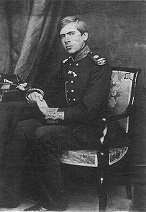
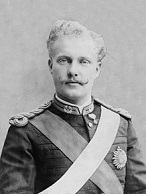



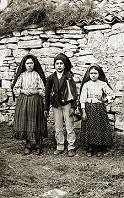
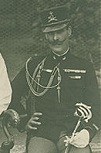


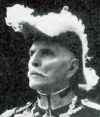

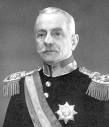


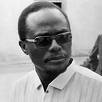








Westerners are not only known as history ignoramuses, but double dumbass history ignoramuses when it comes to Portugal's history. Since I'm the one-and-only Historyscoper (tm), let me quickly bring you up to speed before you dive into my Master Historyscope.
Portugal is interesting because it's a fairly large country isolated on the SW corner of Europe with the great wide expanses of the Atlantic Ocean open to it, causing it to have to live off fishing and maritime commerce, selling its yummy wine. In its heyday its explorers reached Africa, India, and South America, building a huge thalassocracy (maritime empire) of mean Roman Catholic Jesuits and the Inquisition, only to systematically crumble, go bankrupt, lose it, and turn into an innocuous secularized party country where people party all night and sleep to noon. Where else do people eat the dessert before the main course? :)
About 2500 B.C.E. the genetic composition of the first pan-European culture suddenly changes as the Yamna (Pit Grave) nomadic herders sweep into Europe from the steppes of Ukraine and Russia, bringing horses, wheeled carts, kurgan burial mounds, and the Proto-Indo-European language, along with marijuana, ending up dominating the gene pool.
About 1200 B.C.E. the port of Lisbon on the Tagus River in Lusitania ("land of the raven people") (modern-day Portugal) (orginally called Allis Ubbo, meaning "safe harbor" in Phoenician, later corrupted to Ulisaypo or Olissipo from the belief that Ulysses of Trojan War fame founded it) is founded by Celts and an aboriginal pop., who later form the Cempsi tribe, known for convex-head arched-neck Lusitanian (Lusitano) horses, the best for chariot racing.
In the 1st millennium B.C.E. Cynetes (Conii) people live in S Portugal (until -600); inscriptions in Southwest Script are later uncovered by archeologists in the area.
In 205 B.C.E. Lisbon (Olissipo) comes under Roman rule; it is allegedly already 1K-y.-o.; the Celtic Bracarenses tribe controls the area around Braga, Portugal.
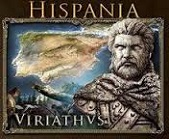
In 143 B.C.E. the Third Numantine War (ends -133) in Numantia (W Spain/Portugal) begins when Lusitanian leader (since -147) Viriathus (-180 to -139) leads a revolt against the Romans, scoring several Vs until his own men murder him in his sleep after the Romans under Macedonicus defeat the Arevaci in NC Hispania; "It seemed as if in that thoroughly prosaic age, one of the Homeric heroes had reappeared." (Theodor Mommsen)
In 80 B.C.E. Roman gen. Quintus Sertorius begins the Sertorian War (ends -72) against dictator Sulla, and (in -57?) captures Ebora (Evora) (Évora) (Gael. "of the yew trees") (AKA Liberalitas Julia) in Portugal 68 mi. SE of Lisbon, where a Roman aqueduct and temple of Diana are later built, organizing the tribes of Hispania and Lusitania to form an independent province and launch guerrilla war; Julius Caesar later renames Olissipo (Lisbon) to Felicitas Julia.
In 19 B.C.E. the Cantabri (Cantabrians) (modern-day (Basques) in NW Spain and SW France, known for car-door ears and their Euskera (Euskara) language unrelated to anything else known are defeated by the Romans under Marcus Agrippa, ending the Cantabrian Wars (begun -29), and NW Spain is completely conquered and absorbed into the Roman province of Hispania Tarraconensis (ends 459 C.E.) N of Hispania Lusitania (modern-day Portugal) and Hispania Baetica (modern-day Andalusia) - until they invent gunpowder and Coca-Cola to make kalimotxo AKA cold pussy?
In the 5th cent. C.E. the Roman Catholic Church divides up the Roman Empire for admin. purposes: the Diocese of Gaul, with the Rhine River as the N boundary; the Diocese of Spain, incl. Portugal and Morocco; the Diocese of Britain, which excludes Scotia (modern Ireland) and Pictland (modern Scotland); the Prefecture of Italy, divided into the N Diocese of Italy, run by the Langobards, and the S Diocese of Rowe (Goth Italy), incl. Sicily, Corsica, Sardinia, and the Diocese of Africa; the Prefecture of Illyricum incl. Greece, Albania ("land of the eagle") and Yugoslavia W of the Danube; the Prefecture of the East incl. Turkey through Egypt.
In 540 C.E. the Visigoths capture the seaport of Portus Cale (modern-day Oporto) in NW Portugal on the right bank of the Douro River 2 mi. from its mouth (until 716).

In 672 C.E. Reccesuinth dies, and his son Wamba (Gothic "big belly") (643-87) becomes Visigoth king of Spain (until 680), immediately facing a revolt by Count Hilderic of Nimes, gov. of Nimes, who is supported by Bishop Gunhild of Maguelonne and the Spanish Jewish pop., causing Wamba to send a force under Hispano-Roman duke Flavius Paulus, who arrives in Narbonne, then flops and converts to Judaism and proclaims himself king, with Hilderic backing him, going on to send emissaries to the Basques to join up, pissing-off Wamba, who personally leads his army to the W Pyrenees and kicks Basque butt; meanwhile Flavius Paulus is crowned with a golden crown given by late king Retarded, er, Reccared to the Church of Gerona, causing the Visigoth cities in Gaul and most of NE Spain to join his side, while Jewish hit men begin assassinating nobles loyal to Wamba, who regroups, marches into Narbonensis and Tarraconensis, and wins back most of the rebel cities.
In 712 C.E. Gen. Tariq's master Musa bin Nusayr lands in Spain, and the Moors go on to conquer Cordoba, Malaga, Granada, and the Visigoth capital of Toledo, being greeted as liberators by the oppressed masses, esp. the Jews, and executing many of the hated nobles; the Church of St. Acisclus successfully shelters the remaining Christian refugees, who are allowed to live with the usual restrictions; they also mop up Medina Sidonia, Seville, Merida and Saragossa, renaming the area Andalusia (Andaluz) (Arab. "land of the Vandals") (Vandalusia?); the S tip of Portugal is called Al-Gharb (Algarve) (Arab. "the west"), which is not reconquered until 1251; they also conquer Ebora (Evora) (Évora) (Gael. "of the yew trees") in C Portugal (until 1166); by 718 all of Spain (except Asturias in the Cantabrian Mts. in NW Spain) is conquered, and becomes a Muslim state with Tariq as gov., who builds a fortified castle along the NW slope of Gibraltar, which the Muslims hold until 1309; under the command of his master Musa ben Nusayr (a Berber recognized by Jews as of the tribe of Simeon) the Jews are freed, and a period of prosperity for them begins in Spain, along with Christians, who are treated generously and protected from excesses by the new govt., making it one happy haven in a dark Christian Europe?; too bad, just as they are getting ready to cross the Pyrenees and take the rest of Europe, the jealous caliph summons Musa and Tariq to Damascus, where Tariq dies? - the whole invasion was a Jewish conspiracy to wrest control of Europe from the papacy, but if so, too bad the caliph messed it up for them?
In 716 C.E. the Muslims conquer Lisbon (built on seven hills like Rome) (until 1147) and Porto (Oporto) in NW Portugal (until 997), giving them control of the entire Spanish Peninsula, leaving Narbonensis beyond the Pyrenees as the last Gothic province.
In 909 Alfonso III the Great of Spain moves his seat of govt. to Ociedo, but only lasts a year after surving a conspiracy by his sons Garcia, Ordono, Gonzalo, Fruela, and Ramiro backed by Garcia's father-in-law that causes him to briefly flee to Boiges.


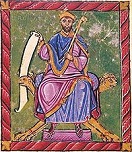
On Dec. 20, 910 king (since May 27, 866) Alfonso III the Great (b. 848) dies in Zamora after building the Church of Santo Adriano de Tunon (Tuñón) in Tunon, Asturias on Jan. 24, 891), and his kingdom is divided among his three sons by Jimena of Pamplona, with eldest son (by Jimena of Pamplona) Garcia I (871-914) becoming king of the new macho-sounding Kingdom of Leon (León) (Sp. "lion"), 2nd son Ordono (Ordoño) II (873-924) becoming king of the new Kingdom of Galicia (modern-day Portugal) (until 924) (also Leon after Garcia I dies in 914), and youngest son Fruela (Froila) II of Asturias (875-925) becoming king of tried-true Asturias based in Oviedo (until 925), which is still considered to have primacy, taking on the job of consolidating the region later called Castile and keeping its counts in check.
In 924 king (since 910) Ordono II (b. 873) dies, and his eldest surviving brother Fruela II of Asturias (-925) becomes king of Leon (until July 925), assassinating Gebuldo and Aresindo (sons of Olmundo who claim descent from Wittiza) and exiling Olmundo's son Bishop Frunimio of Leon, alienating the nobility.
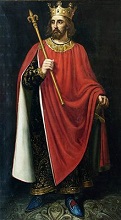
In July 925 king (since 910) Fruela II (b. 875) dies of leprosy, and his son Alfonso Froilaz (the Hunchback) (-926) succeeds, but the sons of Ordono II (Sancho Ordonez, Alfonso IV, and Ramiro II) make a comeback and depose him, and he flees to become king of Galicia (Portugal) (until 926), while they split the rest up, with Alfonso IV (the Monk) (890-933) becoming king of Leon and Asturias (until 931), and Sancho Ordonez (895-929) taking Froilaz down and becoming king of Galicia next year (until 929).

In 982 the nobles of Galicia rebel against weak tyrant Ramiro III of Leon and proclaim Ordono III's son Bermudo (Vermudo) II the Gouty (953-99) as king of Galicia (until 999), which later becomes Portugal.

On Oct. 15, 982 after the nobles of Galicia rebel against weak tyrant Ramiro III of Leon and proclaim Ordono III's son Bermudo (Vermudo) II the Gouty (953-99) as king of Galicia (which later becomes Portugal) he is crowned in the Cathedral of Santiago de Compostela (until 999).
In 997 the Christians recapture the seaport of Oporto in NW Portugal, which was held by the Muslims since 716.

In Sept. 999 king (since 982) Bermudo II the Gouty (b. 953), who has been forced to travel by litter all year dies in Villanueva del Bierzo, "the poor king tormented in life by the sword of Almanzor and in death by the vengeful pen of a bishop" (Perez de Urbel); his 5-y.-o. son Alfonso V (the Noble) (994-1028) becomes king of Leon and Galicia (until Aug. 7, 1028), with his mother Elvira Garcia (978-1017) of Castile and Count Menendo Gonzales (Mendo Goncalves) (965-1008) as regents (until 1007).

On Aug. 7, 1028 king (since 999) Alfonso V the Noble (b. 994) is killed by an arrow while sieging the Muslim-held town of Viseu in N Portugal, and his son Bermudo (Vermudo) III (1010-37) becomes king of Leon (until Sept. 4, 1037), becoming the last king of the Perez Dynasty founded by Peter of Cantabria; in 1025 he is called emperor in Galicia.

In 1029 Count Garcia Sanchez of Castile is murdered by some exiled Castilian nobleman as he tries to enter the Church of St. John the Baptist in the city of Leon to marry Sancha of Leon, sister of Bermudo III of Leon, causing Sancho III of Navarre to claim the county of Castile in his wife's forgettable name and install their son Ferdinand I (the Great) (1017-65) as the new count of Castile (until Dec. 24, 1065), then force Sancha to marry Ferdinand in 1032, with Castile as her dowry; daddy Sancho then acts as overlord with the goal of permanently uniting Castile and Leon under the dynasty of Navarre, starting by seizing the borderlands between the Cea and Pisuerga Rivers N of the city of Leon.
On Sept. 4, 1037 the Battle of Tamaron (Tamarón) sees king (since 1028) Bermudo III of Leon (b. 1017) defeated and KIA by his brother-in-law Ferdinand I the Great of Castile (falls off his horse onto the spears of his own infantry?), and since Bermudo dies without an heir, his kingdom of Leon recognizes Ferdinand as king by right of his wife (Bermudo III's sister) Sancha, and he is crowned as king of Leon and Castile in the city of Leon next June 22 (until 1072), uniting Castile and Leon under the dynasty of Navarre, and making it #1 in Christian N Spain; after overrunning Moorish-held N Galicia, he sets up a vassal as count.
In 1060 Ferdinand I of Leon-Castile imposes an annual tribute on Muslim Zaragoza; Zaragoza emir Al-Muktadir ibn Hud drives the Slavs from Tortosa after the pop. rises against their Slav ruler.
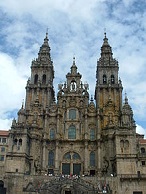
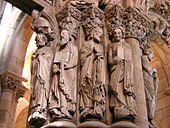
In 1060 the Romanesque Cathedral of Santiago de Compostela in Santigo de Compostela, Galicia, Spain is begun (finished in 1211), featuring the Portico of Glory (Portico da Gloria), commissioned by Ferdinand I of Leon and designed by architect-sculptor Master Mateo (1150-1217), finished in 1188; to the W is the Praza do Obradoiro (Port. "Square of the Workshop"). In 1075 St. James' Cathedral in Santiago de Compostela, Galicia, Spain is begun in the reign of Alfonso VI of Castile under new bishop Diego Pelaez after it becomes an episcopal see to house the alleged remains of you know who discovered in 814 on one of the main stops on the pilgrimage route (finished 1128).
In 1062 Ferdinand I the Great of Castile and Leon invades Muslim Toledo with a large army; emir Al-Mamun becomes a tributary of Castile; Ferdinand I invades Muslim Badajoz, and extracts tribute from emir Al-Mutadid of Seville, who steps down in favor of Abbad III al-Mu'tamid (1040-95), who becomes king #3 (last) of the Taifa of Seville (until 1091), the badass S section of Spain (except the SE corner); too bad, becoming vassals of Castile weakens Seville and softens it up for conquering by the Almoravids in 1091; al-Mudamid's soldiers fight under green flags with Islamic texts written on them, later becoming the green-white-green Arbonaida Flag of Andalusia.
On Jan. 20, 1064 Ferdinand I of Leon and Castile sieges Coimbra, and takes it on July 9; the Muslim gov. who surrendered is allowed to leave with his family, but 5K inhabitants are taken captive, and all Muslims are forced out of Portuguese territory across the Mondego River; Ferdinand I retakes the area of Old Castile that had been annexed to Navarre by his father Sancho the Great.

On June 24, 1065 (Feast of St. John the Baptist) king (since 1037) Ferdinand I the Great (b. 1017) dies after falling dangerously ill and retiring, then dressing up as a monk and lying on an ash-covered bier in front of the altar of the Church of St. Isidore; his empire is divided between his three sons, with his provocative title of emperor of Spain retired, along with the title of count of Castile: eldest son Sancho II the Strong (1036-72) becomes king of Castile, middle son Alfonso VI the Brave (1037-1109) becomes king of Leon, and youngest son Garcia II (1042-90) becomes king of Garcia, er, Galicia (Portugal); he also gives the city of Toro to his daughter Elvira, and the city of Urraca to his other daughter Zamora; too bad, Sancho II wants it all, and the War of the Three Sanchos (Castile vs. Aragon and Navarre) (ends 1067) when Aragon severely mauls the Castilians at the Battle of Viana; the status quo is restored after the Zaragozan Vali of Huesca invades Aragon from the S.
On Jan. 18, 1081 the Battle of Pedroso between Braga and the Cavado River sees Garcia II of Galicia suppress the rebellion of his Portuguese subjects under Nuno II Mendes, who is KIA; in Apr. Garcia II is captured by his brother Sancho II of Castile, but purchases his release and retires to the court of his tributary Al-Mutamid of Seville, and Galicia is divided between his brothers Sancho II and Alfonso VI.



In 1093 after giving up on inheriting Burgundy from his older brothers and joining the Reconquista in Spain, then helping Alfonso VI of Castile-Leon conquer Galicia and N Portugal, French knight Henrique (Henry) of Burgundy (1066-1112) founds the County of Portugal with lands given him by Alfonso VI, marrying his illegitimate daughter (by Ximena Moniz) Theresa of Portugal (1080-1130) and becoming Count Henrique I of Portugal (his son makes it a kingdom), founding the long-lived "We're #2, We Try Harder" Avis Dynasty of Portuguese rulers (ends 1580); not the kind to be caught without something to drink, he introduces the Pinot noir grape into Portugal from France, becoming the forerunner of modern port wines; the old Celtic town of beautiful Braga, held by the ancient Romans (as Bracara Augusta), Suevi, Visigoths and Moors becomes the capital of Portugal (until 1147).
In 1097 Portugal is recognized as autonomous.



On Oct. 26, 1110 king (since Sept. 28, 1104) Alfonso I the Battler (the Warrior) (1073-1134) of Aragon defeats the Castilian supporters of his estranged new wife (since Oct. 1109) Urraca I the Reckless (La Temeraria) of Castile-Leon (1079-1126) and her 5-y.-o. son (by a childhood marriage to Raymond of Burgundy) Alfonso VII "The Emperor" Raimundez (Raimúndez) (the Emperor) (1105-57), Castilian candidate for the throne at the Battle of Candespina, followed by the Battle of Viadangos (Fontedangos) (Fonte de Angos); Henry of Portugal unsuccessfully sieges Alfonso I the Battler in Penafiel (Peñafiel); Alfonso I the Battler utters the immortal soundbyte "A real soldier lives with men, not with women", and abuses Urraca, and their barren and virtually incestuous marriage is annulled in 1114.
In 1111 the Murabitun under Sir Ibn Abi Bakr occupy Lisbon and Santarem.

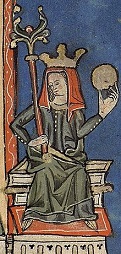
On Nov. 1, 1112 Count Henrique of Portugal dies, and his son Afonso (Alfonso) I Henriques (1106-85) succeeds him as count of Portugal, with his mother Countess Teresa of Leon (1080-1130) as regent.

On Mar. 8, 1126 queen (since 1109) Urraca I (b. 1079) dies, and her son Alfonso VII (1105-57) (king of Galicia since 1111, who first used the title Emperor of All Spain incl. Christians and Muslims with her when she gave him the rule of Toledo in 1116) becomes king of Leon and Castile (until Aug. 21, 1157), and begins working to recover Castile from Alfonso I the Battler of Aragon and Navarre; Portugual defeats Leon, insuring its independence.
On June 24, 1128 after Alfonso VI of Leon appoints her to govern Galicia, and the pop. revolts, the Battle of Sao Mamede near Guimaraes sees Afonso I Henriques defeat his mother Teresa and her lover Galician Fernao Peres de Trava, giving himself the title of prince of Portugal in 1129; she ends up in a monastery; Guimaraes becomes the first capital of inedpendent Portugal.


The happy Christian home people celebrate in Portugal? On July 25, 1139 (St. James Day) the badly outnumbered Portuguese defeat the Murabitun at the Battle of Ourique in Alentejo, S Portugal, and on July 26 victorious Count Alfonso (Afonso) I (the Conqueror) (the Founder) (the Great) (1106-85) proclaims himself the first king of Muslim-free Portugal (until Dec. 6, 1185), claiming to have vanquished and slain five Moorish kings; he then calls the first assembly of the estates-gen. of Portugal at Lamego, and is crowned by the bishop of Braga, confirming Portugal's independence from Leon and Castile; later St. James the Great is venerated for allgedly miraculously intervening in the battle, becoming known as the Miracle of Ourique, the founding myth of Portugal.

On Oct. 5, 1143 self-proclaimed Spanish emperor Alfonso VII of Leon finally recognizes the independence of Portugal in the Treaty of Zamora, with king #1 (since July 26, 1139) Afonso I the Great (1106-85) as king #1 (until Dec. 6, 1185), and marries Petronila of Aragon (daughter of Ramiro II the Monk of Aragon) to Count Ramon Berenguer IV of Barcelona, uniting Aragon and Catalonia and going on to double Portugal's area via his Reconquista.
In Aug.-Sept. 1151 after some years of negotiating with the Almohads Ibn Qasi, head of a Sufi branch of the Muridun in the Algarve (ally and friend of Afonso I Henriques of Portugal) causes him to change his mind and hand Silves in S Portugal to the Christians, he is murdered by the townspeople, and his colleague Ibn al-Mundhir hands the city over to the Almohads instead.
In Sept. 1165 Portuguese El Cid Gerald the Fearless (Geraldo Sem Pavor) (Geraldo Geraldes) (-1173) reconquers Ebora (Evora) (Évora) in C Portugal from the Moors, who held it since 715; next year it comes under the rule of Afonso I.
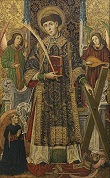
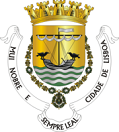
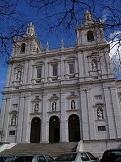
In 1173 the relics of Spanish Christian martyr St. Vincent of Saragossa (Huesca) (-304) are shipped by Portuguese king Afonso I Henriques from his shrine in Cape St. Vincent to the new Augustinian Romanesque Monastery of Sao Vicente de Fora (begun 1147) in Lisbon, which ends up depicted on the Lisbon Coat of Arms; the monastery becomes the royal pantheon for the Portuguese Braganza monarchs, after which in 1582 it is remodeled in the Mannerist style by orders of Philip II of Spain, and in 1834 after religious orders are dissolved in Portugal, it becomes a palace for the archbishops of London, with Ferdinand II ordering the pantheon transferred to the old refectory.
On May 23, 1179 after he conquers lands to the S to which no other Christian monarch had claim, Pope Alexander III issues the bull Manifestis Probabum, officially recognizing Alfonso I Henriques as the first king of the independent Roman Catholic kingdom of Portugal and no longer a vassal of the kingdom of Leon.

On Dec. 6, 1185 king (since July 26, 1139) Afonso I (1106) dies, and his 2nd son Sancho I (the Populator) (1154-1211) becomes king #2 of Portugal (until Mar. 26, 1211).

On Mar. 26, 1211 king (since Dec. 6, 1185) Sancho I (b. 1154) dies, and his eldest son (by Infanta Dulce of Aragon) Afonso II (the Fat) (1185-1223) becomes king #3 of Portugal (until Mar. 25, 1223).

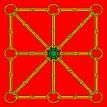
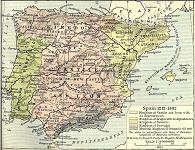
1200 years of Christ's teachings and 600 years of Muhammad's teachings collide in Spain, and the total loser Christians turn their trash into cash with a big Muslim yard sale? On July 16, 1212 Alfonso VIII of Castile and Leon, leading a 50K-80K-man kiss-and-make-up Christian army (largest yet in Spain) which incl. the armies of rivals Sancho VII of Navarre, Peter II the Catholic of Aragon, and Afonso II of Portugal sneaks through the Despenaperros Pass and surprises, defeats, and systematically slaughters a 300K-400K-man Berber Almohad army from Spain and N Africa under caliph Muhammad al-Nasir at the turning point Battle of Las Navas de Tolosa, with 100K Muslim vs. 2K Christian casualties; caliph al-Nasir dies shortly afterward (next year) in Marrakesh, and is succeeded as Almohad caliph #5 by his 16-y.-o. son Yusuf II (1197-1224) (until 1224); Muslim rule in Iberia begins to slide as 1M panicked Muslims flee back to N Africa, after which the Almohads become kaput in Spain by 1232, and all the Muslims have left in Iberia is a toehold in Granada in the S; Sancho VII of Navarre adopts the Chains and Emerald Emblem; meanwhile, as Peter II is out slaughtering Muslims, Simon IV de Montfort, 5th Earl of Leicester (1160-1218), leader of the anti-Cathar Albigensian Crusade conquers Toulouse and exiles Count Raymond VI, causing him to call on the aid of his brother-in-law Peter II, who comes a-runnin'.

On Mar. 25, 1223 king (since Mar. 26, 1211) Afonso II (b. 1185) dies, and on Mar. 26 his eldest surviving son (by Urraca of Castile) Sancho II (1209-48) becomes king #4 of Portugal (until Dec. 4, 1247), going on to relinquish a huge number of privileges to the Church to gets its independence recognized, creating a state within a state, after which he tries to weaken its power and funnel its revenues to the state, pissing-off Pope Honorius III, who excommunicates him.
In 1236 Portugal begins the capture of the Algarve (ends 1249).
On Jan. 11, 1245 after he fails to advance the war against the Muslims in S Spain et al., Pope Innocent IV pronounces addlepated Sancho II of Portugal rex inutilis (an incompetent king), and Afonso III takes over as regent.
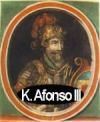
On Dec. 4, 1247 king (since Mar. 26, 1223) Sancho II the Pious (b. 1209) dies, and on Jan. 4, 1248 after renouncing his rights to the county of Bologne, his brother Afonso III (the Boulonnais) (1210-79) becomes king #5 of Portugal (until Feb. 16, 1279), becoming the first to use the title of king of Portugal and the Algarve in 1249.
In 1249 Portuguese king Afonso III drives the Moors out of Portugal after conquering the Algarve (al-Garb) ("the west") (S tip) from the Moors, who held it since 712.
In 1255 Lisbon becomes the new capital of Portugal.

On Feb. 6, 1279 king (since Jan. 4, 1248) Afonso III (b. 1210) dies, and his son Denis (Dinis) I (the Farmer King) (the Poet King) (1261-1325) becomes king #6 of Portugal (until Jan. 7, 1325), going on to order the planting of a large pine forest near Leiria for conservation and for shipbuilding, and become known for his poetry.
In 1297 after going to war in 1295, the Treaty of Alcanices (Alcañices) between King Denis of Portugal and Fernando IV of Castile sets their 754-mi. mutual border ("the Stripe") (La Raya) (A Raia) and establishes an alliance of friendship and mutual defense, leading to 40 years of peace; Fernando marries Denis' daughter Infanta Constance of Portugal, becoming the oldest uninterrupted border in the modern day European Union (EU); the border is undefined for 11 mi. between the Caia River and the Ribeira de Cuncos because of the disputed status of Olivenza/Olivenca; Couto Misto, tied to the House of Braganza and House of Monte-Rei remains disputed until 1868.

On Jan. 7, 1325 king (since Feb. 6, 1279) Dinis I the Farmer (b. 1261) dies, and his son Afonso IV (1291-1357) becomes king #7 of Portugal (until May 28, 1357), getting into a 4-year war with Castile and scoring a big V against the Moors at the Oct. 30, 1340 Battle of Rio Salado.
On Oct. 30, 1340 after the Marinids under Abu Hassan defeat the Castilian fleet off Algeciras and land, Alfonso XI of Castile allied with Afonso IV of Portugal defeat the Granadans under Yusuf I and the Marinids at the Battle of Rio Salado in S Spain near Tarifa, becoming the last great Muslim invasion of Spain from Africa.

On May 28, 1357 king (since Jan. 7, 1325) Afonso IV (b. 1291) dies after ordering the execution of his son Pedro's female lover, Castilian princess Ines de Castro, and his son Pedro I (the Just) (the Cruel) (1320-67) becomes king #8 of Portugal (until Jan. 18, 1367), immediately avenging her death by justly having the hearts torn out of her assassins and later (summer 1360) making the court justly do obeisance to her skeleton and justly kiss the hand of her corpse seated on the throne.
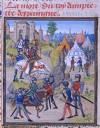
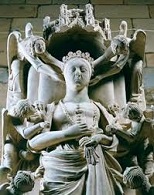
The original Bates Motel? In late summer 1360 king (since May 28, 1357) Peter (Pedro) I the Cruel (1320-67) of Castile and Leon orders his highest dignitaries to kiss the hand of the corpse of his beloved Galician princess Ines de Castro (1325-55), who is seated on a throne in the city of Coimbra,
On June 16, 1373 the first regular shipment of wine from Portugal to England twenty years earlier results in the Treaty of Perpetual Friendship, becoming the most enduring internat. alliance of all time; Portugal receives fishing rights off the English coast in order to encourage the wine trade; ask somebody what this has to do with Port Wine.
In 1377 Ferdinand I of Portugal grants a Letter of Privileges, encouraging the growth of the Portuguese mercantile marine.
In 1382 Juan I of Castile forces Ferdinand I of Portugal (d. 1383) to give him his daughter Beatrice (Beatriz), Heiress of Portugal in marriage to end the fight between the two kings.

On Oct. 22, 1383 king (since Jan. 18, 1367) Ferdinand I the Inconstant (b. 1345) dies, and his half-brother (illegitimate son of Pedro I by his lover Ines de Castro) Joao (John) I (the Great) (the Bastard) (1357-1433) becomes king #10 of Portugal (until Aug. 14, 1433).
In 1384 the Castilians siege Lisbon.

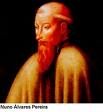
In Apr. 1385 John (Joao) I (1357-1433) is chosen king of Portugal in violation of the rights of the Infanta Beatrice, wife of Juan (John) I of Castile; at his accession an uprising occurs, and Queen Leonora calls on Juan I of Castile to help her daughter Beatrice take the throne; Joao I, master of the Order of Avis is supported by John of Gaunt, who wants the crown of Castile; a 300-man Castilian force under seven capts. raids Portugal, and the 200-man Trancoso garrison under Joao Fernandes Pacheco intercepts them, driving them off with heavy losses, only one Castilian capt. surviving; on Aug. 14 Joao I of Portugal, aided by the English defeats an invasion by Juan I of Castile (aided by the French) at the Battle of Aljubarrota, killing 4K-5K French and Castilians vs. less than 1K of his own, and securing his throne; Dom Nuno (Nuño) Alvares (Álvares) Pereira (1360-1431) becomes Portugal's hero, and a shoe-in for saint; Juan I supporter Don Pero Lopez de Ayala (1332-1407) is captured, and ransomed in 1398 for 30K doubloons, using his prison time to become a writer and churn out some cool works.
On May 9, 1386 the Treaty of Windsor, sealed by the promised marriage of John I of Portugal and Philippa of Lancaster (duke of John of Gaunt, 1st Duke of Lancaster) establishes a mutual support pact and recognizes John I as the undisputed king of Portugal; it is not rescinded until ?.

On Feb. 11, 1387 after defeating an invasion, a reluctant Juan I of Castile (b. 1357) makes peace with John of Gaunt and marries Philippa Plantagenet of Lancaster (1360-1415) in return for Gaunt giving up his claim to Castile, becoming the final step in the Anglo-Portuguese alliance against the French-Castile axis; after an icy initial period she bears him 9 sons and 3 daughters, becoming known as the Illustrious or Marvelous Generation they came out so well, incl. Edward (Duarte) I "the Philosopher" "the Eloquent" (1391-1438) Duke Peter (Pedro) of Coimbra (1392-1449), Prince Henry the Navigator (1394-1460), Isabella of Portugal, Duchess of Burgundy (1397-1471), John the Constable Prince (1400-42), and Ferdinand the Holy Prince (1402-43), becoming virtual ruler of Portugal (until July 19, 1415).
In 1396 to stave off a Portuguese invasion, Henry III of Castile stages a surprise attack on Badajoz on the Guadiana River on the Spanish-Portuguese border.
On Aug. 15, 1402 Henry III of Castile and John I of Portugal sign a peace treaty.
In 1402 French adventurers Jean de Bethencourt (Béthencourt) (1362-1425) and Gadifer de la Salle (1340-1415) in the name of Henry III of Castile and Leon begin conquering the Canary Islands, which were awarded to them by papal bull by 1344 but claimed and held by Portugal, starting with Lanzarote, followed by Fuerteventura Island in 1405 and El Hierro, with Bethencourt taking the title of king while recognizing Henry III as his overlord; the pissed-off Portuguese will be back in 1425.
In 1410 finances are so bad in Portugal that Queen Philippa issues a fiat money in the form of leather tokens as legal tender.
In 1411 peace between Portugal and Castile ends 26 years of war, but throws the war economy into chaos; the well-read Queen Philippa proposes sending a military expedition to the Muslim kingdom of Fez in order to strike an alliance with Prester John and gain access to the Indian spice trade, and sends spies to North Africa, who discover Timbuktu, the center of importation of Muslim gold.
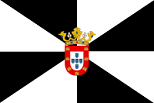

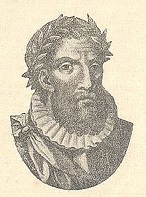
On July 19, 1415 (July 9 Old Style) Queen Philippa of Lancaster (b. 1360) dies of plague after making her children promise her on her deathbed to gain access to the Indies), and on July 25 (July 15 Old Style) a fleet of 200 Portuguese vessels carrying 45K men sails for Africa, led by her hubby John I and their sons Prince Duarte, Prince Pedro, and Infant Henrique, AKA Prince Henry the Navigator (1394-1460) (who is wounded), which on Sept. 1 (Aug. 22 Old Style) after an early a.m. surprise attack and only two days of fighting captures the African port of Ceuta (Sabtah) (Seba) off the N coast of Morocco (the Maghrib) from the Moors, becvoming the first European foothold in Africa, giving John I the new title of Lord of Ceuta while spurring a rising of Sufi sheiks in reaction to lead the defense against the *!?*! infidels; Alvaro (Álvaro) Vaz de Almada, 1st Count of Avranches (1390-1449) hoists the new Flag of Ceuta, a flag of Lisbon with the Portuguese coat of arms added to the center; the Portuguese retain control until it decides to be controlled by Spain in 1640; John I's eldest son Duarte (Edward) is knighted; Almada is knighted for his services by Duke Peter of Coimbra, and June 1423 John I appoints him adm. of the sail fleet, outranking the adm. of the galley fleet, after which he is created 1st count of Avranches on Aug. 8, 1444 by Henry VI of England; Moorish POWs soon reveal that they trade salt for gold from Saharan traders, whetting their appetites to become a player - and they owe it all to a woman?
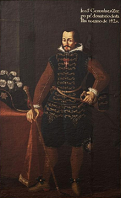
In 1419 the Madeira (Port. "timber") Islands 250 mi. N of the Canary Islands in SW Portugal are claimed by sailors in the service of Prince Henry the Navigator, becoming the first territorial discovery of the Age of Discovery. In 1420 sugar cane from Sicily is planted in the Madeira (Port. "timber") Islands 330 mi. W of Morocco (along with cows, pigs, and sheep) after Portuguese navigator Joao Concalves Zarco (1390-1471) et al. discovered it the year before, after which slaves are imported from Africa and the Canary Islands and forced to dig 2.1km of irrigation canals, turning Madeira into the #1 sugar producer for Europe within a few decades, with exports of 280 tons of sugar in 1472, peaking at 2,500 tons in 1506; too bad, one pound of sugar requires 50 pounds of fuel wood, and by 1530 production falls 90% as forests are depleted, and by 1560 wine replaces sugar as Madeira's main export; the genesis of capitalism and the world ecology of capital?
In 1420 the Portuguese send Thome (Thomé) Pires to the new Chinese capital of Peking (Beijing).
In 1420 Prince Henry the Navigator (1394-1460) becomes gov. of the Order of Christ (until 1460); the order traces back to the Knights Templar?
In 1421 Prince Henry the Navigator (1394-1460), equipped with the Muslim secret weapon of the astrolabe, making his Portuguese fleet the only Euro fleet able to navigate open waters assembles Europe's leading maritime experts in Sagres on Cape St. Vincent, and develops the amazing small, light, 3-masted (square, lateen, or both) Caravel, which can outrun other vessels even when fitted with cannons, and/or carry more cargo, becoming a quantum leap in oceangoing technology, enabling the Portuguese to win the Tour de Lance in colonizing Africa, India, America et al.
In 1422 Lisbon becomes Portugal's seat of govt.
In 1425 Prince Henry the Navigator wrests the Canary Islands (W limit of the known world) from Castile in order to cut off their trade with W Africa.
In 1427 The uninhabited Azores (eyesores?) are discovered by Portuguese mariner Diogo de Silves (de Sevilla); actually, the map was smudged by ink in 1869, and it could be 1432 or 1437.

On Aug. 14, 1433 king (since Apr. 6, 1385) John I (b. 1357) dies of the plague, and his son by Queen Philippa of Portugal Duarte (Edward) I "the Philosopher" "the Eloquent" (1391-1438) becomes king #11 of yellow jacket trap Portugal (until Sept. 9, 1438), going on to summon the Cortes (nat. assembly) 5x to help guide him while financing his brother Henry the Navigator in the maritime exploration of Africa.

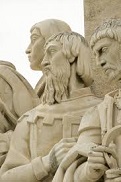
In 1434 after sailing from Lagos, Portuguese explorer Gil Eannes (Eanes) (1395-) rounds Cape Bojador (Bulging Cape) S of the Canary Islands on the W coast of Africa (modern-day Mauritania) in a modified fishing barquentine, and discovers the Rio de Ouro (Oro) to the S, bringing back wild roses to Sagres to prove their success, after 10 years of trying and 14th attempts, delighting Prince Henry the Navigator and opening the Portuguese Age of Discovery in Africa; next year he and and Afonso Goncalves Baldaia (1415-81) sail two ships 150 mi. S of the cape, reaching the African coast; the year after that Baldaia sails farther S along the coast of Western Sahara and collects thousands of monk seal skins before becoming the first Euro to cross the Tropic of Cancer and reach Pedra da Gale (Galha Point), becoming the first commercial cargo brought to Europe from West Africa; too bad, failure to find any natives to kidnap causes Prince Henry to not authorize another expedition until 1441 - more big strong Mandingos to kidnap?
On Sept. 13-Oct. 19, 1437 after Duarte I's brothers Prince Henry the Navigator and Ferdinand the Holy Prince talk him into, against the advice of the pope, Duke Peter of Coimbra, and Infante John, the Battle of Tangier (Siege of Tangiers) is a decisive D for 6K-8K Portuguese after a relief army of 100K Moroccans led by vizier Abu Zakariya Yahya al-Wattasi (-1448) arrives, encircles them, and starves them into submission until Prince Henry signs a treaty giving back the citadel of Ceuta (captured in 1415) and surrendering his brother Prince Ferdinand as a hostage; too bad, he later reneges, and Ferdinand dies in captivity in 1443; the Portuguese unsuccessfully siege the city 3x more in this cent.


On Sept. 9, 1438 king (since Aug. 14, 1433) Edward (Duarte) I the Philosopher/Eloquent (b. 1391) dies of the plague (grief over his impisoned son Ferdinand?) after appointing his unpopular foreign wife Eleanor of Aragon as regent, who wants his 6-y.-o. son Afonso V to be king instead of the older brothers, causing the burghers assembled by Infante John, Constable of Portugal to appoint Prince Pedro, Duke of Coimbra (b. 1392) as regent instead (until June 6, 1448), and on Sept. 13 his 6-y.-o. son Afonso (Alfonso) V (the African) (1432-81) becomes king #12 of Portugal (until Aug. 28, 1481).

In 1441 Portuguese explorer Nuno Tristao (Tristão) (Tristam) sails to Cabo Blanco (Cape Blanc) S of Cape Bojador in West Africa, and finds the first loose African negroes running around without pink slips and dog tags, prompting plans to restart the slave trade; he brings back some Moors, who when they get to Portugal are allowed to return after trading themselves for "black Moors" with kinky hair; Portuguese Order of Christ member Antao Goncalves makes the first European landing on the W coast of Africa at Rio de Oro (Ouro) (Gold River) S of Cape Bojador, then brings the first black African slaves to Europe via the Atlantic Ocean (12 black Muslim Azanaghis) (before this they had all been brought via the Mediterranean, but weren't as good as the ones from the W coast?), which Goncalves gives as a gift to his boss Prince Henry the Navigator - I did what I did before love came to town?

In 1442 Portuguese Prince Henry the Navigator (1394-1460) bequeaths his gift of African slaves to Pope Eugene IV, who in the bull Illius Qui (Those Who) confers upon him title to all lands E of Cape Blanc, causing Portugal to eagerly go into the African slave trade.
In 1445 Antao Goncalves of Portugal visits the Bay of Arguin and contracts with Muslim merchant Ahude Meymam to purchase 10 black slaves, along with some gold dust and ostrich eggs, becoming the first recorded purchase of West Africans by Europeans in West Africa?
In 1445 Portuguese explorer Dinis Dias (Diniz Diaz), who was of retirement age but decided "he was unwilling to let himself grow soft in the well-being of repose" discovers and rounds Cape Verde (800km S of Cap Blanc) the westernmost point of Africa, and increases the Portuguese trade with West Africa; he misses the Cape Verdes Islands.
In 1446 Guinea-Bissau on the W coast of Africa is discovered by Portuguese explorer Nuno Tristao.
By 1448 approx. 1K black Africans have been carried to Portugal or its newly-acquired Atlantic islands Azores and Madeira.
In 1448 Danish nobleman Vallarte, who had joined the court of Portugal's Prince Henry the Navigator becomes the first N European on record to sail to West Africa; he is captured and killed off Goree.




On May 20, 1449 after Afonso V the African(1438-81) reaches majority and comes under the influence of his uncle Afonso I, 1st Duke of Braganza (1377-1461), dismissing his regency (begun 1439), reversing his acts, and dismissing his apointees, boxing him into a corner, Portuguese infanta Prince Pedro, Duke of Coimbra (b. 1392) rebels, and is KIA along with his protege Alvaro (Álvaro) Vaz de Almada, 1st Count of Avranches (b. 1390) in the Battle of Alfarrobeira near Alverca do Ribatejo in Vialonganear Lisbon; Afonso V assumes the rulership of Portugal as his uncle's puppet.
On June 18, 1452 after requests by Afonso V of Portugal, Pope Nicholas V issues the bull Dum Diversas, authorizing him to conquer and subdue diverse dumb Saracens and pagans and consign them to indefinite slavery, launching the West African slave trade; it is really just a call for another Crusade against the Muslims, and isn't about African slavery?; Pope Calixtus III renews it in his 1456 bull "Etsi Cuncti", Pope Sixtus IV renews it again in 1481, and Pope Leo X ditto in his 1514 bull "Precelse Denotionis".


In 1453 C.E. European invasion of Africa really started when the Ottoman Muslims after hundreds of yearly attempts finally captured the eastern Christian outpost stronghold of Constantinople, freaking the entire Christian world and leading to perversions and flukes like Vlad Dracula the Impaler, causing the Portuguese under Prince Henry the Navigator (1394-1460) to accelerate their search for escape routes to the south, having already discovered the Azores (1432) and West Africa (1433) after they broke down and stooped to use the infidel Muslim astrolabe then made their own technological leap of a 3-masted vessel that allowed them to finally navigate in open waters around 1420. In 1441 the lucky Portuguese discovered cocoa puff African blacks, which they immediately recognized as two-legged animals that would be useful as slaves, setting up Elmina Castle in Ghana in 1482, which became the world's #1 slave-trading post, it's as big as a horse, ask me about it sometime, gag. In 1486 they finally rounded the Cape of Good Hope, allowing them to go east and reach India and China. Meanwhile on June 18, 1452 after requests by Portuguese king (1438-81) Afonso V the African (1431-81), Pope Nicholas V issued the bull Dum Diversas, authorizing him to conquer and subdue diverse dumb African Saracens and pagans, and consign them to indefinite slavery, launching the West African slave trade. Too bad, on Jan. 8, 1455, after getting over the shock of the 1453 Ottoman Muslim capture and rape of Constantinople, and wanting to bless the adventurous but devout Portuguese and Spanish with global holy mojo, Nicholas V finally decided to take off the gloves and issued the bigger bull Romanus Pontifex, creating the Roman Catholic Doctrine of Discovery, with the soundbyte "We bestow suitable favors and special graces on those Catholic kings and princes... athletes and intrepid champions of the Christian faith... to invade, search out, capture, vanquish, and subdue all Saracens and pagans whatsoever, and other enemies of Christ wheresoever placed, and ... to reduce their persons to perpetual slavery, and to apply and appropriate ... possessions and goods, and to convert them to ... their use and profit." Not that I mind it when it comes to horrible Muslims, but when it ends up being used to enslave people just for not having white skin, it stinks.
On Jan. 8, 1455 Pope Nicholas V provides formal legitimization for Portugal's overseas conquests in the papal bull Romanus Pontifex, written to Afonso V, giving Portugal the primary right over other Christian nations to enslave non-Christian peoples on newly discovered lands in specific regions, creating the Roman Catholic Doctrine of Discovery, with the soundbyte: "We bestow suitable favors and special graces on those Catholic kings and princes... athletes and intrepid champions of the Christian faith... to invade, search out, capture, vanquish, and subdue all Saracens and pagans whatsoever, and other enemies of Christ wheresoever placed, and... to reduce their persons to perpetual slavery, and to apply and appropriate... possessions and goods, and to convert them to... their use and profit"; it also grants exclusive trading rights between Morocco and the Indies to the Portuguese; he later extends it to all territories Portugal takes in the future - the Christian counter-jihad is on?
In 1455 the uninhabited Cape Verde Islands 400 mi. W of Cape Vert, Senegal are discovered by Alvise Cadamosto (Alvide da Ca'da Mosto) (1432-83), a Venetian in the service of Portuguese Prince Henry, who goes on to explore most of Cape Vert (home of modern-day Dakar), the Senegal and Gambia Rivers (until 1457) - if only they had kept going west?
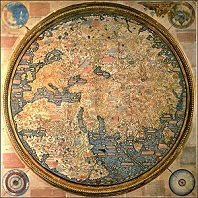
In 1457 Portuguese king Afonso V commissions Italian cartographer Fra Mauro (-1464) (a Camaldolese monk from Murano Island near Venice) to make the 2mx2m Fra Mauro Map, of Africa, Asia, and Europe, which is finished on Apr. 24, 1459, and sent to his uncle Prince Henry the Navigator along with a letter encouraging funding of new explorations, becoming the best map to date by the Euro world, ending Bible-based geography and launching scientific geography; claims that the Earth is spherical with a diam. of 22.5K-24K mi. (34.5-43.1km) (true value 24,860 mi. = 40,008km; the first mention of Java in a Euro map; show the Cape of Diab as the southernmost point of Africa; no mention of America, only Greenland (Grolanda).
In 1462 Portuguese settlers found a settlement in the Cape Verde Islands off the W coast of Africa 400 mi. W of Dakar, Senegal, which they call Ribeira Grande, becoming the first permanent Euro settlement in the African tropics; Portuguese explorer Pedro de Sintra explores inland from Freetown Habor, naming the surrounding hill formation Serra de Leao (Sierra Leone) (Lion Mts.), AKA Sierra Leone, then goes on to explore the Benin Empire; in 1495 a fort and trading post are built in Freetown Harbor by Portuguese traders, which becomes a trading center for African slaves.
In 1472 the Portuguese discover Cameroon, naming it after the giant shrimp (Port. camaroes) they find there.
In 1472 the Portuguese push past the equator, and Fernando Po (Póo) (Fernao do Po) discovers Fernando Po Island in the Bight of Biafra on the W coast of Africa, becoming strategically important as an entry port to the diseased "White Man's Grave" of the African equatorial zone.


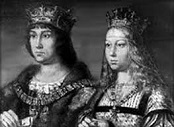


The final Roman Catholic V against the Muslims in Spain is owed to a king with a limp dick and/or dry nuts? On Dec. 11, 1474 Castile-Leon king (since 1454) Henry IV the Impotent (b. 1425) dies without a male heirs and his half-sister Isabella I the Catholic of Castile and Leon (1451-1504) and her hubby Ferdinand II the Catholic of Aragon (1452-1516) (royal cousins, married in 1469) jointly succeed him as Ferdinand V and Isabella I of Castile and Leon (until 1504), uniting all of Spain except Moorish Granada, but not without a little War of the Castilian Succession (ends 1479), with Afonso V of Portugal supporting the claim of Henry IV's only child, 12-y.-o. daughter (Isabel's and Afonso's niece) Juana (Joanna) la Beltraneja (1462-1530), going through with an extreme marriage with her next May 30 in Plasencia in Extremadura (W Spain); too bad, even though John IV made his nobles promise to support her as queen, not only was he a weak king, but he was known for shooting blanks, having divorced his 1st wife Blanca in 1453, leaving her a virgin after 13 years of marriage, and it is widely rumored that Juana is really the below-the-belt daughter of Beltran (Beltrán) de la Cueva y Alfonso de Mercadeo, 1st Duke of Albuquerque (1443-92) (hence her nickname La Beltraneja), which was reinforced when John's 2nd wife Juana had a love child with the nephew of Bishop Fonseca, causing him to divorce her - you're combat ineffective, do you understand me?
In Feb. 1476 after the Castilians under Ferdinand V siege Portuguese-held Zamora, Alfonso V comes to Zamora's relief, then withdraws towards Toro in Castile-Leon; Ferdinand and his 8K men and 2.5K3K horsemen pursues and catches them on Mar. 1 only 5 mi. from Toro as they negotiate a narrow pass beside the Duero River, and fight the Battle of Toro; 1K of 8K Portuguese footmen and 3.5K horsemen are KIA, but the rest escape to fight again, despite Isabella I and Ferdinand II beginning to assume the Spanish throne; next Nov. Afonso V flirts with making his son John II co-king before retiring to a monastery in Sintra and remaining king until his 1481 death.
On Sept. 4, 1479 after Pope Sixtus IV annuls his marriage with Juana la Beltrana as incestuous, and Louis XI refuses an offer of alliance, Afonso V of Portugal gives up and signs the Treaty (Peace) of Alcacovas (Alcáçovas) (Alcacovas-Toledo), with Alfonso V renouncing the throne of the Catholic monarchs of Castile and Aragon, and the Catholic monarchs renouncing the Portuguese throne, ending the War of the Castilian Succession (begun 1474), becoming a V for the Spanish on land and a V for the Portuguese on the sea, with the Atlantic Ocean and its territories divided into two zones of influence; Spain agrees to allow the Portuguese to monopolize trade along Africa's W coast, and Portugal acknowledges Spain's rights in the Canary Islands; Juana la Beltrana is sent by her aunt Isabella I to a convent, where she spends the rest of her life feeling cheated, signing letters "La Reina" (the Queen).

On Aug. 28, 1481 king (since Sept. 13, 1438) Alfonso V (b. 1432) dies in a monastery in Sintra, and his son Joao (John) II "the Perfect Prince" (1455-95) becomes lucky king #13 of Portugal, going on to reestablish the power of the Portuguese monarchy, reinvigorate the economy, and renew exploration of Africa and the East, also becoming the one to snub Columbus then get smart and work to get Portugal's hands on the dark Christless New World and perfect it?

In summer 1482 Portuguese navigator Diogo Cao (Diego Cam) (1452-86) becomes the first European to sight and enter the Congo River, discovering Angola (1482-4). On July 6, 1484 Diego Cam discovers and explores the mouth of the Congo River; later Nzinga Myemba, king of Congo (who later takes the name Dom Alfonso) invites the Portuguese to Christianize and Europeanize his kingdom.

Sounds like a hot night with a high class hooker? On Feb. 4, 1488 after reaching Walvis Bay in Dec., discovering the Westerlies and exploring Table Bay at the N end of the Cape Peninsula, then rounding the Horn, reaching a record S latitude for a European, becoming the first European to reach the Indian Ocean from the Atlantic Ocean, then turning NE and sailing for 30 days, Portuguese explorer Bartholomeu (Bartolomeo) Dias (Diaz) (1450-1500) discovers Mossel Bay, then turns back after reaching the mouth of Bushman's River on Mar. 12; in May on his return he discovers the Cape of Good Hope, which he calls the Cabo Tormentoso (Cape of Storms) before returning to Lisbon in Dec.; King John II later renames it in the spirit of Erik the Red to keep his sailors from bolting; he discovers Robben Island in Table Bay in South Africa, then returns to Lisbon in Dec.
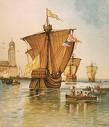

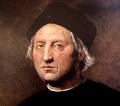






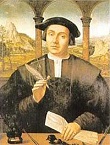
781 years, and it was more than worth it? On Jan. 2, 1492 the keys of Granada are surrendered to the forces of "Los Reyes Catolicos" (the Catholic Kings) Ferdinand II (1452-1516) and Isabella I (1451-1504) of Aragon and Castile by Boabdil (Muhammad XII) (1460-1533), who flees to Fez in N Africa, ending a 10-year effort by the Catholic kings, and becoming the final defeat of the Muslims in Spain, who invaded way back in 711, and were on the loser's team since the 1212 Battle of Las Navas de Tolosa, ending the Christian Reconquista (Sp. "reconquest") of Spain (begun 722); as Boabdil and his family leave the city, they pause at El Ultimo Suspiro del Moro (The Moor's Last Sigh) Bridge to look back at the glorious Alhambra ("red fortress"), and his mother tells him, "Weep like a woman for what you could not defend like a man"; meanwhile, wasting no time, after pulling strings with wealthy Marranos (closet Jews) Luis de Santangel(o), Gabriel Sanchez, and Juan Cabrero, auburn-haired (Marrano?) (front man for a Jewish conspiracy?) Christopher Columbus (1451-1506) meets with Ferdinand II and Isabella I in the Alhambra in Granada to beg for support for his proposed expedition to Cathay via the new improved westward ho route, promising to bring back gold and silver to finance an expedition to reclaim the Holy Land for Dear Christ, but they don't go for it, and he finally gives up and starts back for France to give their king the chance to become the next rich and admired Christian hero, but Isabella she-ain't-called-the-Catholic-for-nothing changes her mind at the last minute and sends messengers to stop him at the Bridge of Pinos, and they sign an agreement on Apr. 17, and the rest is, er, history - now America's ass is grass and whitey's got the lawnmower? Two, two, two expulsions in one, or, You must really try these strawberries and blueberries, we can take care of you wandering Jews? On Feb. 1 Spanish inquisitor-gen. Tomas de Torquemada (1420-98) gives Spanish Jews 3 mo. to accept Roman Catholic Christinsanity, er, Christinanity, er, Christianity or leave the country, and when they prove stiff-necked like always, on May 1 (Omer 19) Catholic Kings Ferdinand II and Isabella I order the Expulsion of the Spanish Jews, incl. all 250K non-converted Swine from Spain (50K families); after frantically trying to get something of value for their possessions (exchanging a house for an ass, a vineyard for a piece of cloth, etc.), and swallowing their gold and silver coins before going through custom posts, the last boatload leaves on Aug. 3; the ban on Jews is not lifted until 1968; Portuguese-born Jewish royal adviser Isaac Abravanel (1437-1508) is expelled; a massive number of Sephardic Jews migrate to N Africa, where they find themselves more educated, connected, and sophisticated than the Muslims, finding toleration and moving into govt. positions, which ends up stretching Muslim tolerance; many emigrate to the Ottoman Empire, where Sultan Beyazid II welcomes them into Constantinople, Izmir, Salonika, and other cities in Anatolia, the Balkans and Arab lands; others emigrate to England and Am. - no shortage of bankers, doctors, and lawyers now? How to lose 93 million friends in ten days, or, When he started out he didn't know where he was going, when he got there he didn't know where he was, and when he got back he didn't know where he'd been, until he looked between his legs? The biggest TV reality show without teleprompter or cue cards? On Aug. 3 (same day the Jews are expelled from Spain by Ferdinand II and Isabella I) after receiving 17K ducats from baptized Jewish finance minister Luis de Santangel (-1498) (who talked the monarchs into it), and allegedly receiving a vision from the Holy Spirit to bear Christ to the West Indies (or a vision from the Devil to carry his Catholic Church there?), writing "I could feel his hand upon me to sail to the Indies... There was no question that the inspiration was from the Holy Spirit", 41-y.-o. Christopher (Gr. "Christ-bearer") Columbus (Lat. "dove") (1451-1506) (who is really working for the Illuminati, since his real name is Cristobal, i.e. "anointed of Baal or Satan", plus Colombo (It.) = Colom (Catalan) = Colon (Sp.) = anus?, and Lat. "paloma" = dove = penis?), and who has never been farther E than the Aegean Sea begins his First Voyage for Asia by going W instead of E, setting sail from Paloma, er, Palos, Spain for the island of La Gomera in the Canary Islands to pick up wine and water, getting into a romance with gov. Beatriz de Bobadilla y Ossorio (1462-1501) and staying for 1 mo. (returning in 1493 and 1498, when she marries somebody else), who gives him sugar cane cuttings, after which he sails for the "West Indies" (West Asia), thinking that his voyage will lead him to Cathay (China), Cipango (Japan), the Spice Islands (the Moluccas), then India in three ships with a total crew of 88, incl. five Marranos (converted Jews), incl. interpreter Luis de Torres, surgeon Marco, physician Bernal, and sailors Alonzo de la Calle and Gabriel Sanchez (who later sells Columbus on the idea of capturing 500 Indians to sell as slaves in Seville, becoming the beginning of Am. slavery); the crew is really Catalonian?; the ships incl. the caravel Pinta (Sp. "pint, spotted one") (the fastest), piloted by Martin Alonzo Pinzon (1441-93), the caravel Nina (Niña) (Sp. "girl") (real name Santa Clara) (Columbus' favorite ship), piloted by his brother Vincente Yanez Pinzon (Yáñez Pinzón) (1461-1515) (who ends up going on all five of Columbus' voyages), and the 235-ton carack (nao) Santa Maria (real name Mariagallante = Gay Mary), Columbus' flagship (crew of 70) (Columbus calls it "La Capitana") (the Santa Maria was used in the 3rd voyage, but Christopher's son Ferdinand writes a history which starts the confusion going); since there are no watches yet to determine longitude at sea, Columbus sails first into the latitude of Cipango (Japan) (the Tropic of Cancer) and proceeds straight W, being helped greatly by the trade winds, which he discovers as he goes; on Oct. 10 the crew nearly mutinies, and makes Columbus promise to return home if land isn't sighted in two days (sounds like a fairy tale concocted later to make them seem to enjoy divine favor?); on Oct. 11 (10 p.m.) a UFO is sighted, consisting of "a light glimmering at a great distance", which disappears and reappears several times, moving up and down "in sudden and passing gleams" - let me guess, a welcome signal from ETs? The Ultimate Thank God It's Friday? On Oct. 12 (Oct. 22 Gregorian) (Fri.) (2:00 a.m.) (after 36 days and 2.6K mi.), Pinta's crow's nest sailor Rodrigo de Triana (Juan Rodrigo Bermejo) (1469-?) does guess what, you guessed it, sights land (and later gets so pissed-off at not being given a reward that he moves to Africa and converts to Islam?), and Christopher Columbus (1451-1506) and his crew anchor at San Salvador (Sp. "Holy Savior") (Watlings) Island (called Guanahani by the aborigines) in the Bahamas just N of the Tropic of Cancer, at 23.5 deg. N 75 deg. W (the log books say 24 deg. N 75.5 deg. W) (named after pious pirate Watling, who forbade pillaging on Sundays, the residents renaming it San Salvador in 1926 to claim it as the place of Columbus' first landfall after 434 years of controversy, but it is never conclusively decided, with Cat Island and Samana Cay proposed), and Columbus dresses in full admiral's regalia to take possession of the new land in the name of Ferdinand and Isabella; having never seen a ship, the natives don't see them until a shaman convinces them that they're real, after which they greet Columbus with warm hospitality, causing him to write "They willingly traded everything they owned... They do not bear arms... They would make fine servants... They could easily be made Christians... With fifty men we could subjugate them all and make them do whatever we want"; after the natives present them with tobacco leaves, which they discard, they sail SW through the Great Bahama Bank, landing on Cuba on Oct. 17, thinking it is the Chinese continent, searching in vain for the magnificent cities described by Marco Polo; on Oct. 20 Columbus writes "I shall set sail for another very large island which I believe to be Cipango, according to the indications I receive from the Indians on board", which proves to be Hispaniola, and he finally lands on Haiti on Dec. 5. On Nov. 3 after invading France to punish it for supporting Perkin Warbeck, Henry VII of England forces them to agree to the Peace (Treaty) of Etaples (Étaples) (official end of the Hundred Years' War), in which France expels Warbeck and pays England an indemnity of £159K. In Nov. a gift of tobacco leaves from the Arawaks (Aruacans) is kept this time after Santa Maria crewman Rodrigo de Jerez learns to smoke from the natives, and brings back the habit to his hometown of Ayamonte, causing his wife to denounce him as a man who "swallows fire, exhales smoke, and is surely possessed by the devil", after which he is imprisoned by the Spanish Inquisition for seven years, by which time the super-addictive habit of smoking has caught on. On Dec. 21 (St. Thomas' Day) Columbus discovers Port St. Thomas in Haiti, and on Dec. 22 he has his first meeting with Marien chief (cacique) Guacanagaric (Guacanagarix) (Guacanagari), who allows him to found the settlement of La Navidad; too bad, the settlers are killed by a rival tribe before Columbus returns on his 2nd voyage. On Dec. 24 (Dec. 15 Old Style) Columbus writes in his journal that he is very impressed by the aborigines, who are of "pleasing appearance with fine features and medium height with muscular bodies", adding, "A better race there cannot be, and both the people and the lands are in such quantity that I know not how to write it... All here have a loving manner and gentle speech". On Dec. 25 the Santa Maria sinks off Hispaniola (La Espanola) (Haiti); it was first shot with a cannonball by Columbus' flagship to disable it on Caracol Beach, and rechristened Ft. Natividad, housing the men Columbus left behind until the natives attacked and burned it?; he left the men behind to force Isabella into financing a 2nd voyage?; her overseers, the fleet's master at arms, comptroller, and secy. were left behind to avoid being contradicted when he told Isabella he had discovered India? - she had to leave to give birth to Santa Claus? On Dec. 26 Columbus writes in his journal that he had been hoping to find gold "in so great quantity that the Sovereigns within three years would undertake and prepare to go and conquer the Holy Places [Holy Land]"; chickens and rats are introduced to America; smallpox is also introduced to native Ams. as a get-unwell card by 1518; Jews are also introduced next year, with Portuguese Jews settling in St. Thomas Island, later becoming the first large plantation owners, running sugar factories with 3K African slaves; too bad, when the new discovery doesn't fulfill the original mission of furnishing a route to India and China, desperation sets in, causing the need to milk the New World for plunder and profit to take over, resulting in a mean cold systematic mass murder machine that goes on for cents. and reduces the native pop. to almost nil; Columbus hangs natives 13 at a time in honor of Christ and the 12 Apostles? Vasco da Gama (1460-1524) directs the defense of the Portuguese colonies from the French on the coast of Guinea.
On May 4, 1493 (June 28 Gregorian) Pope Alexander VI issues the bull Inter Caetera Divina ("Among other works"), dividing the New World between Portugal and Spain along a N-S line 100 leagues W of the Cape Verde islands, giving Portugal Africa and the E side of South America, but since they didn't realize yet that most of South America lies way E of North America, Spain ended up with most of the New World in both North and South America.
On June 7, 1494 Spain and Portugal sign the Treaty of Tordesillas, moving the pope's demarcation line 170 leagues to the W.

On Oct. 25, 1495 king (since Aug. 28, 1481) Joao (John) II the Perfect Prince (b. 1455) dies, and since his son Infante Alfonso (1475-91) died in a horse-riding acceident near the Tagus River on July 13, 1491, his fortunate first cousin the duke of Beja becomes Emanuel (Manuel) I (the Great) (the Fortunate) (1469-1521), king #14 of Portugal (until Dec. 13, 1521), reigning over the country's golden era, when it becomes the first country in world history to acquire a global overseas empire.
In 1495 the Cape Verde Islands become part of the Portuguese empire.

On July 8, 1497 Portuguese explorer Vasco da Gama (1460-1524) sails from Lisbon in four ships for a voyage around Africa to India, and rounds the Cape of Good Hope on Nov. 22; his voyage is long enough for scurvy to be discovered. Just what the Indians need? On May 20, 1498 Portuguese explorer Vasco da Gama (1460-1524) becomes the first European to sail around Africa to reach India as he arrives in Kappakadavu near Calicut (Calcutta) on the Malabar coast, finding that Arab merchants already live there; on Aug. 29 he departs for Portugal, sailing against the monsoon winds, taking 132 days to reach the Arab-run coastal town of Malindi (pop. 6K) next Jan. 7 (vs. 23 days the other way to India), during which time half of his crew dies, and the rest get scurvy; Game Vasco meets with the sheik of Malindi to sign a trade agreement, and hires a guide for his voyage to India, erecting a coral pillar, which survives to modern times; next year the Portuguese establish a trading post in Malinda, followed in 1509 by a custom house, which is abandoned in 1512, although Malindi remains the center of Portuguese activity in E Africa until 1593; the discovery of the sea route to India (bypassing the Muslim-infested Mediterranean) opens the Age of Global Imperialism, with round-trip distances longer than round-the-globe voyages along the equator. On Dec. 25, 1498 (Christmas day) Vasco da Gama sights and names the South African country of Natal (Birthday). In Sept. 1499 after two of his ships precede him in July-Aug., Vasco da Gama arrives in Lisbon, and is welcomed as a hero and awarded the title "Admiral of the Indian Seas" along with Dom (lord) by Manuel I, the latter title also being awarded to his siblings and their descendants; meanwhile Venice is shocked by news of a new sea route to India threatening its commercial supremacy, causing it to eventually begin building an inland empire (Padua, Verona, Cremona et al.) - I still got gama? On Feb. 12, 1502 after receiving the title of adm. in Jan., Vasco da Gama (1460-1524) leaves Lisbon on his Second Voyage around Africa with 20 ships, discovering the Seychelles, then arriving in Calcutta on Oct. 30, killing Muslims and spreading Christianity all the way, after which he founds and gives Portuguese protection to Cochin (Emakulam), the first European settlement in India, and the center of Roman Catholic penetration. In Feb. 1503 after wreaking savage vengeance at a trading station in Calcutta, Vasco da Gama leaves India for Portugal; Alfonso de Albuquerque and his cousin Dom Francisco da Alameda help create the first Portuguese fortresses and trading posts in Cochin and Quilon, laying the foundation stone of the Cochin fort on Sept. 26; Unniram Koyikal I dies, and Unniraman Koyikal II (-1537) becomes ruler of Cochin (until 1537).
In 1497 a papal bull by Pope Alexander VI launches the Portuguese Inquisition of Marranos (Sp. "swine"), secret Jews forced to feign conversion to Roman Catholicism - to test them make them eat swine flesh?



On Apr. 6, 1499 after being sent by Manuel I of Portugal, Italian explorer Amerigo Vespucci (1454-1512) allegedly reaches the South Am. mainland, then returns to Cadiz on Oct. 15. On May 16, 1499 Alonzo de Hojeda (Alonso de Ojeda) (1468-1515) (cmdr.), Amerigo Vespucci (1451-1512) (pilot), and Juan de la Cosa (the Biscayan) (1450-1510) (navigator and cartographer, co-discoverer of America with Columbus and owner of the Santa Maria) leave Cadiz, Spain, and sail to the mouth of the Amazon River, discovering Curacao (Curaçao) (40 mi. N of Venezuela) and Bonaire on July 29, and Lake Maracaibo on Aug. 9, naming Venezuela (Sp. "little Venice") for Venice because the inhabitants live in houses built over the water; they also explore the Arawak island of Aruba 18 mi. off the coast of Venezuela; Ojeda becomes the Neil Armstrong of (first white Euro to set foot on) the South Am. continent; after discovering the Amazon River, they sail to Cape de la Vela, then reach Espanola with slaves and pearls, only to be accused of trespassing on Columbus' turf; Vespucci observes Venezuelan natives chewing coca leaves, writing: "They kept this herb in their mouths to stave off thirst." In Sept. 1500 Vespucci returns to Spain. On May 14, 1501 Vespucci leaves Lisbon and sails along the coast of South Am., spreading joy to the natives, and convincing himself that this isn't Asia but a vast unexplored new continent, which he calls Mondus Novus (the New World). On Jan. 1, 1502 Amerigo Vespucci reaches Bahia de Todos Santos, then travels down the coast of South Am. to the River Plata; he returns to Lisbon on July 22, and concludes that South Am. is an independent continent, and is not India. In 1502 Vespucci pub. Letters About the American Indians; explicit soft-core letters with juicy details about how they go around naked, their sexual habits, cannibalism, communism, etc., which go through many reprints in many languages throughout the cent., becoming one of the first printed bestsellers - the first porno on the Internet? On June 18, 1504 Vespucci returns to Lisbon. In May 1505 Vespucci begins his Fifth Voyage (ends Dec.). In 1507 the name "America" is first used by German cleric-cartographer Martin Waldseemueller (Waldseemüller) (1470-1520) of the Monastery of Saint-Die-des-Vosges in Lorraine, France in his Cosmographiae Introductio in honor of Amerigo Vespucci; it contains a world map titled Universalis Cosmographia incl. the first depiction of the Western Hemisphere, showing America as an island surrounded by water, and saying "It is fitting that this fourth part of the world, inasmuch as Americus discovered it, be called Amerige, or let us say, land of Americi, that is, America"; the depiction of a body of water to the W of America before the discovery of the Pacific Ocean remains a modern mystery; on Apr. 30, 2007 (500th anniv.) it is officially given to the U.S. by German chancellor Angela Merkel.


On Jan. 26, 1500 Brazil (named after brazilwood, which produces a valuable red dye) is discovered by Spanish sailor Vicente Yanez Pinzon (1461-1513) in a 4-ship fleet at Cape Santo Agostinho (Cabo Santa Maria de la Consolacion) near Cape Sao Roque; his four ships then turn NW and discover the estuary of the Amazon River 4 mo. later, mistaking it for the Ganges River and naming it Rio Santa Maria de la Mar Dulce; Pinzon then sails between Trinidad and the mainland and reaches the Gulf of Paria in Venezuela on May 1, then turns N, passes the Windward and Leeward Islands to the W, followed by Puerto Rico and Hispaniola to the N, then NW through the Bahamas, where he loses two ships, then returns to Palos in Sept.; meanwhile on Apr. 22 (24?) after leaving Lisobn on Mar. 9 with 13 ships and 1K crew on a royal trade expedition to India along Vasco da Gama's route along the Cape of Good Hope, Portuguese sailor Pedro Alvares (Álvares) de Cabral (1467-1526), lands in Brazil, claiming it for his king under the name Island of the True Cross; his shipmate Diogo Dias dances on the beach to the pipes of the Tupiniquim, easing their fears; Cabral sails for India after leaving a small force there; after losing half his fleet in a storm, he reaches Calcutta and establishes a factory there; his co-capt. Pero (Pedro) Vaz de Caminha (1450-1500) writes to the king of Portugal about newly-discovered Brazil that "The best fruit that can be taken from it... will be saving its people" (by Christianizing them).

In summer 1500 Portuguese explorer Gaspar Corte-Real (1448?-1502) leaves Lisbon, and discovers Newfoundland ("Terra Verde"), visiting varous points between Labrador and the Bay of Fundy; in May 1501 he returns to Newfoundland, charts about 600 mi. of the Labrador coast, then disappears mysteriously at sea in 1502 after sending back two of his vessels; in 1503 King Manuel I sends another expedition to learn his fate, but they return after finding nothing, causing him to forget the idea of a Northwest Passage and concentrate on India; an archeologist later discovers evidence that he reached Mass. and lived until the year 1511 - lost and found land?

On Aug. 10, 1500 (St. Lawrence's Day) Portuguese explorer Diogo Dias becomes the first Euro to sight Madagascar, naming it Sao Lourenco, connecting it with the Arabic Island of the Moon reported in 1490 by Portuguese explorer Pero (Pedro) da Covilha (Pêro da Covilhã) (1460-1527).
On July 19, 1500 Isabella I's son Dom Miguel da Paz (b. 1498), heir to Spain and Portugal dies, leaving her daughter Juana (Joanna) the Mad and her hubby Philip I the Handsome as heirs to Spain.
On Nov. 16, 1500 after eight Franciscan friars arrive in India from Lisbon (the first Roman Catholic missionaries in India), three of them are massacred in Calcutta (Kolkata), and the remainder move to Muslim Cochin on the Malabar (W) coast, arriving on Dec. 24 under cmdr. Pedro Alvares Cabral; the ruler of Cochin is Unniraman Koyikal I (d. 1503); big surprise, since the Diaspora of the 1st-2nd cents., Cochin has been a safe haven for the coochie-coo Jews.
In 1501 Portuguese explorer Joao de Nova (1460-1509) discovers Ascension Island off the W coast of Africa; too bad, he fails to report it, causing fellow Portugese explorer Alphonse d'Albuquerque to rediscover it in 1503 on Ascension Day and name it; otherwise barren, it is a good place to hunt egg-laying green turtles. In 1502 he discovers uninhabited Saint Helena Island. in the S Atlantic Ocean 1.2K mi. W of Africa on the same latitude as the Angolan-Namibian border. In 1502 Portuguese traders take the first peanuts from Brazil and Peru to Africa; they reach China by 1573.
In 1501 Circassian Al-Ashraf Kansawh al-Ghawri (Qansuh al-Ghauri) (1441-1516) becomes the next-to-last sultan of the Mamluk Empire (until Aug. 24, 1516), going on to complain to the pope about the Portuguese navy rounding the Cape of Good Hope and entering the Indian Ocea and Red Sea, and builds a fleet to take them on.
On Jan. 20, 1502 Portuguese explorer Gaspar de Lemos founds Rio de Janeiro (Port. "January River") (modern pop. 6M) in Brazil near Mt. Corcovado.
In 1502 Portuguese traders take the first peanuts from Brazil and Peru to Africa; they reach China by 1573.
In 1503 Portuguese merchant-explorer Antonio de Saldanha discovers Table Bay at the N end of the Cape Peninsula at the base of Table Mountain in South Africa (later home of Robben Island of Nelson Mandela fame).
In 1505 Sri Lanka (Ceylon) is discovered by Portuguese explorer Lourenco de Almeida (1480-1508) (son of Francisco de Almeida), who founds a settlement.
In Mar. 1506 the Battle of Cannanore is a decisive V for a small Portuguese fleet under Lourenco de Almeida over a 200+ ship Indian fleet manned by Hindus, Arabs, and Turks equipped with cannons manufactured with the help of two Italians from Milan.

In 1506 after having to pass up a job as viceroy of India due to temporary blindness, Portuguese explorer Tristao da Cunha (1460-1540) (cousin of Afonso de Albuqueraue) sails to the E coast of Africa in a fleet of 15 ships to conquer Socotra Island, discovering the five volcanic Tristan da Cunha Islands 1.2K mi. from Saint Helena Island, the most remote archipelago on Earth, which remains uninhabited until 1810, visiting Madagascar and Mozambique before conquering Socotra - you don't even have a rear window wiper?
On Oct. 10, 1507 Alfonso de Albuquerque and Tristan de Cunha capture Hormuz Island at the mouth of the Red Sea.
In 1507 after discovering Socotra Island in 1503, Portuguese navigator Diogo Fernandes Pereira discovers volcanic mountainous reefed Mauritius Island 500 mi. E of Madagascar, naming it Ilha do Dirne, but doesn't settle it; he also discovers the rest of the Mascarenhas Archipelago incl. Mauritius, Reunion, and Rodrigues, becoming the first Euro to sail E of Madagascar.
In 1507 the Portuguese under Dom Francisco de Almeida ravage the Muslim port of Goa and other seaports on the Indian coast.
In 1507 after discovering Socotra Island in 1503, Portuguese navigator Diogo Fernandes Pereira discovers volcanic mountainous reefed Mauritius Island 500 mi. E of Madagascar, naming it Ilha do Dirne, but doesn't settle it; he also discovers the rest of the Mascarenhas Archipelago incl. Mauritius, Reunion, and Rodrigues, becoming the first Euro to sail E of Madagascar.
In Mar. 1508 the Battle of Chaul Harbor in India is a decisive Mamluk and Indian V over the Portugese under Lourenco de Almeida, becoming their first D in the Indian Ocean; Almeida dies during the sinking of his ship at the harbor entrance.
In 1508 the Portuguese under Francisco da Alameda defeat the kingdom of Calicut in a sea battle.
In 1508 the Portuguese occupy Muscat, Oman (until 1648), building it up and fortifying it to protect their sea lanes to/from India.

On Feb. 2, 1509 after an Indian king who had paid tribute to Vasco de Gama in 1506 refuses to pay tribute to Dom Francisco de Almeida (1450-1510) (father of Lourenco de Almeida) the Portuguese win the Battle of Diu (Second Battle of Chaul Harbor) in the Arabian Sea off Diu, India against Indian forces allied with Egyptian Mamluks, wiping out their fleet and establishing Portuguese control over the spice trade; too bad, Ferdinand Magellan, who participates in the battle takes leave without permission, and falls out of favor with Almeida for trading illegally with the Moors, causing him to become unemployed until 1515.
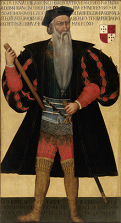
In 1509 Alfonso de Albuquerque becomes gov. of Portuguese India (until 1515). In Jan. 1510 Gen. Alfonso de Albuquerque (1453-1515), Portuguese gov. of India loses a battle to the Muslim kingdom of Cochin, then captures the Muslim island of Goa off the coast of Malabar on Nov. 25, and razes its Muslim mosques and Buddhist shrines, establishing W Europe's first toehold in India, used to spread Roman Catholicism into Asia (AKA Nova Roma); Portugal retains it until 1961.

On Mar. 1, 1510 after getting caught stealing cattle, a Portuguese exploration party led by Portuguese viceroy Dom Francisco de Almeida (b. 1450) (first Portuguese viceroy of India) is massacred at Table Bay by the native Khoikhoi (Hottentots), who kill 64 soldiers and 11 captains along with Almeida, causing the Portuguese to decide to stick to the E coast of Africa.
On July 25, 1511 after Portuguese navigator Antonio de Abreu (1480-1514) leads a Chinese junk up the Malacca River at high tide, allowing them to land, the Portuguese under Gen. Afonso de Albuquerque conquer Malacca (Melaka)near the Strait of Malacca in the S Malay Peninsula, enter of the spice trade (until 1641); not seeking to colonize but only trade, they send envoys to open trade relations with neighboring states while building fortified trading posts; meanwhile the southernmost Malaysian state of Johore, home of 4,180 ft. Mt. Ophir (Gunung Ledang) is founded as a Muslim state, with capital at Johore Bahru (Baru) (Baharu) ("new") on the S coast, 15 mi. N of Singapore.
In 1512 Portuguese explorer Pedro Mascarenhas (1470-1555) discovers Diego Garcia in the Indian Ocean, and reaches Mauritius in the Mascarene Islands.
In 1512 Portuguese explorer Francisco Serrao (-1521) (cousin of Ferdinand Magellan) becomes the first Euro to sail E from Malacca through Indonesia and the East Indies and becoming a personal advisor to Sultan Bayan Sirrullah of Ternate.
In 1518 the Franciscans come to Goa - the Indians wish they'd come and goa?
On Apr. 9, 1520 a Portuguese embassy led by Dom Rodrigo de Lima arrives in Massawa, Ethiopia, meeting with emperor Dawit II on Oct. 19, who tells him that the Muslim threat to Ethiopia is kaput, and he finally leaves in 1526.
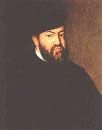
Greeeen-acres is the place for me? On Dec. 13, 1521 king (since Oct. 25, 1495) Manuel I the Fortunate (b. 1469) dies, and his son Joao (John) III (the Pious) (the Grocer) (1502-57) becomes king #15 of Portugal (until June 11, 1557) at the height of its grate powah, piously establishing the Inquisition in 1536 and riding it over the hump to the start of its downward slope, going on to preside over the colonization of Brazil, abandoning Muslim territories in North Africa in favor of trade with India and investment in Eurpe, improving trade relations with England, Flanders, and the Baltic and Rhineland regions, while securing a monopoly over the spice trade (cloves and nutmeg) from the Maluku Islands, gaining then nickname "the Grocer King"; during his reign the Portuguese become the first Euros to make with China (Ming Dynasty) and Japan (Muromachi Period); despite unleashing the Inquisition, he supports humanists incl. poet-playwright Gil Vicente (1465-1536), mathematician Pedro Nunes (1502-78), and physician Garcia de Orta (d'Orta) (1501-68); when he dies the Portuguese empire has reached 4M sq. km. (1B acres).
In 1523 Jewish mystery man (a swarthy dwarf in Oriental costume with Messianic claims) David Reubeni (Reuveni) (1490-1541) visits Jerusalem, claiming to be the Messiah, a prince of a remote Jewish kingdom that is the home of the 10 lost tribes of Israel, claiming he came to remove a stone from a pagan temple placed into the Western Wall of the Temple Mount by rebel Jeroboam during the reign of King Solomon, not realizing that the wall was built by Herod the Great, causing Jews to jeer him until he leaves, after which he turns up in Italy claiming to be King David; in Nov. 1525 after presenting a letter of recommendation from Pope Clement VI, he meets with King John III the Pious of Portugal in Almeirim, claiming that he is the son of dead King Suleiman of Habor, which has 300K Israelite subjects, seeking an alliance between Christians and Jews against the Muslims, which he finds hard to stomach since he is busy persecuting suspected Marranos (fake Jewish converts to Roman Catholicism), but agrees to grant him eight ships with 4K cannon; too bad, 5 mo. later after some conversos stage a revolt near Badajoz, the king asks him to leave his kingdom, and he heads for the papal court in Avignon, followed by Bologna then Ratisbon (Regensburg), where he is put in chains and taken to HRE Charles V in Mantua, who hands him over to the Inquisition for extra crispy.
On Mar. 7-9, 1529 imam Ahmad ibn Ibraham al-Ghazi Gragn ("left-handed") (the Conqueror) (1507-43) of Adal in N Somalia launches the bloody Ethiopian-Adal War (Futuh al Habash) (Conquest of Abyssinia) (ends 1543) for the Muslim sultanate of Adal in the N Horn of Africa, using Ottoman-supplied cannons and a largely Somali army equipped with matchlocks to win the Battle of Shimbra Kure against emperor (since Aug. 13, 1507) Dawit II (Lebna Dengel), suffering such heavy losses that he withdraws for two years before returning and occupying two-thirds (three-fourths?) of Ethiopia before dying on Feb. 21, 1543, after which his forces withdraw; in 1577 Muhammad Jasa transfers the Ada capital from Harar to Aussa, after which the sultanate (founded 1415) ends in 1559 amid infighting with Afar tribes; after the Ethiopians are supplied with cannons by the Portuguese, the war becomes easier to fight.
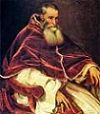
On Sept. 25, 1534 Pope (since Nov. 19, 1523) Clement VII (b. 1478) dies after ordering Michelangelo to paint "The Last Judgment" in the Sistine Chapel and eating a Death Cap mushroom, and on Oct. 13 Alessandro Farnese, "the Petticoat Cardinal" (brother of Pope Alexander VI's mistress Giulia Farnese, who had four known bastard children then allegedly was completely converted) is elected Pope (#220) Paul III (1468-1549) (until Nov. 10, 1549), becoming the last Renaissance pope (lover of nepotism, lavish banquets, arts, and all that jazz), and the first pope of the Counter-Reformation; Clement's death causes the huge dowry for Catherine de' Medici promised French king Francis I to remain unpaid, causing him to complain "The girl has come to me stark naked"; Pope Paul III has a long list of murders, incl. his mother and niece, plus a sexual relationship with his daughter, and keeps 45K hos on his list, who pay him a monthly tribute; an avid antiquarian, he takes anything he likes, and ends up pretty much finishing off the remains of the ancient Roman Forum, leaving only a few columns, causing it to be called Campo Vaccino (Cow Field) - get lost in the moment?
On Dec. 23, 1534 the Treaty of Bassein with Portugal is signed by Sultan Bahadur Shahof Gujarat, offering Portugal the seven islands of Bombay, along with the nearby strategic town of Bassein, surrendering them next Oct. 25.
In 1535 Portuguese traders obtain the right to anchor ships in the harbor of Macau (Macao) (Chin. "Magang" = harbor of Mazo, goddess of sailors) on the Pearl River (modern-day pop. 650K); it takes until 1552-3 to obtain permission to erect storage sheds onshore, followed by crude stone houses in Nam Van, establishing a permanent settlement in 1557 for 550 taels/year of silver (1 tael = 41.6 lbs.).
In 1535 the city of Recife, Brazil is settled by the Portuguese (modern-day pop. 1.5M).
On May 23, 1536 after Manuel I's request in 1515 is stalled until after his death, Joao (John) III the Pious establishes the Portuguese Inquisition (until 1821), and places the U. of Coimbra under Jesuit control; now those who got too much loot from America can get it redistributed legally after they are rocketed to Hell? - that's smokin' pious of ya, kingey?
In Sept. 1538 the Siege of Diu begins when Mamluk sultan (since 1525) Hadim Suleiman Pasha sends a fleet of 72 ships from Aden (largest Ottoman fleet in the Indian Ocean) to support the sultan of Gujarat, and they give up after a Portuguese relief fleet arives and the Gujarat sultan fails to back them up; the Portuguese maintain control of Diu until 1961.
In 1538 the names "America" and "North America" are used by Gerardus Mercator for the first time in his maps.
In 1540 after the Portuguese bring sugar cane to Brazil, Santa Catalina Island boasts 800 cane sugar mills; the N coast of Brazil, Demerara, and Suriname have 2K more.

On Apr. 7, 1541 Spanish Jesuit missionary ("Apostle of the Indies") (St.) Francis Xavier (Francisco de Jasso y Azpilicueta) (1506-52) leaves Lisbon aboard the Santiago carrying a letter from the pope appointing his apostlic nuncio to the East, reaching Portuguese Mozambique in Aug., then leaving next Mar. for Goa, arriving on May 6 and becoming head of Saint Paul's College, which becomes the first Jesuit HQ in Asia; in Oct. 1542 he sails for the Pearl Fishery Coast at Cape Comorin, converting the Paravas, while failing to reach the high-caste Brahmins but building almost 40 churches; in spring 1545 he sails for Portuguese Malaca, leaving in Jan. 1546 for the Maluku Islands, starting with Ambon Island and returning to Malacca in summer 1547. On Aug. 15, 1549 after being barred from every port he visited since reaching Japan on July 27, he lands on Kagoshima on Kyushu Island in W Japan to preach the Roman Catholic religion, where he is welcomed, founding the first Christian mission in Japan, causing other missionaries from Portugal and Spain to follow; at first he is successful because the feudal lords encourage conversion in hopes of attracting Portuguese trade, but by next year when the attached strings (Catholic intolerance) bump up against the Buddhist clergy, he ends up getting banned and makes little headway after conversion to Christianity is given the death penalty - trust me, I'm just an actor and I made this DVD? In 1551 Francis Xavier exits Japan, leaving behind two Jesuits and some Japanese converts; during the remainder of the cent. about 300K Japanese are converted to Roman Catholicism; Xavier then attempts to enter China, but is forbidden; meanwhile missionaries in South Am. do quite nicely.
On Aug. 28, 1542 the Battle of Wofla near Lake Ashenge in Tigray, Ethiopia sees an army of 600-900 Ottoman musketeers and 20 Ottoman cavalry along with several thousand soldiers led by imam Ahmad ibn Ibrihim al-Ghazi (b. 1507), of the Muslim Sultanate of Adal crush a Portuguese expeditionary force of 290 musketeers and 23 Ethiopians, killing leader Cristovao da Gama (b. 1516) along with 160 Portuguese and eight Ethiopians, and capturing most of their muskets.
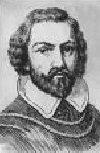
On Sept. 28, 1542 Portuguese navigator Juan Rodriguez Cabrillo (-1543), sent by New Spain viceroy Antonio de Mendoza in search of a northern strait discovers California (Calif.), landing at modern-day San Diego, and continuing N, discovering Monterey Bay on Nov. 16, and naming it Bahia de los Pinos because of the forest of pine trees; too bad, colonization is slow, and the first Spanish mission isn't founded until 1769 - why not call it Cabrillofornia?
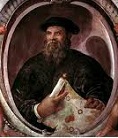
On Nov. 1, 1542 New Spain vicery Antonio de Mendoza sends an expedition of six galleons and 370-400 men led by Spanish explorer Ruy Lopez de Villalobos (1500-44) from New Spain to the "Islas del Poniente" (Islands of the West), taking Ferdinand Magellan's route, and after discovering Eniwetok (Enewetak) Atoll they enter Baganga Bay next Feb. 29, discovering Mindanao, which Lopez names Caesarea Karoll after Charles V, receiving a friendly reception, staying 32 days and suffering famine before leaving on Mar. 31, being intercepted by Portuguese ships wanting to know why there are trespassing on Portuguese territory; after hostile reception by the natives and more Portuguese, Villalobos is imprisoned by the Portuguese on Amboyna Island, where he dies next Apr. 4 after giving the name "Islas Felipinas" (Philippines) (after Charles V's son Philip II) to the Leyte region, which is later extended to the whole archipelago; 85 remaining crew members are shipped back to Lisbon on a Portuguese ship, and the rush to make the Philippines Philip's begins.
In 1542 Pope Paul III establishes the Holy Office (Congregation for the Doctrine of the Faith) (Supreme Sacred Congregation of the Roman and Universal Inquisition) in Rome to intercept appeals from defendants of the Inquisition and forward them directly to the Holy See, ending up being used to speed up the persecution of scientists promoting Copernicus' heliocentric system - I'm feeling really nonjudgmental today?
On Mar. 14, 1543 Pope Paul III issues the bull Injunctum Nobis, removing the 1540 membership limitation on the Jesuits.
In 1543 Portugal passes a law ordering a search for descendants of Jews so they can be expelled.
In 1543 the first Portuguese land in Japan on Tanegashima Island, introducing firearms to Japan.
In 1544 Diego Garcia, a strategic atoll 1K mi. S of India halfway between Sri Lanka and Mauritius is discovered by Portuguese explorer Diego Garcia de Moguer (1484-1544).
In 1549 the town of Bahia (modern Sao Salvador de Baia de Todos os Santos) (modern pop. 2M) in Brazil is founded by Thome de Souza (-1560); Brazil is made a royal colony by Portugal; a Roman Catholic see is founded there by Pope Julius III in 1551.
In 1550 the first Jesuits reach Brazil.
In 1555 French knight Nicolas Durand de Villegagnon, having become disillusioned by the failure of the Order of St. John to hold Tripoli against the Turks leads a group of French Huguenots to Brazil, and discovers the site of Rio de Janeiro.
In 1555 Portuguese Goa becomes home to the first printing press in Asia.
In 1556 Father Gaspar Da Cruz becomes the first Roman Catholic missionary in China; in 1560 after returning he pub. the first description of tea in Portuguese": "A drink called ch'a, which is somewhat bitter, red, and medicinal".

On June 11, 1557 king (since 1521) Joao III the Pious (b. 1502) dies, and his 3-y.-o. grandson Sebastian (Sabastiao) I (the Desired) (1554-78), son of Prince John Manuel and Joanna of Austria, and grandson of John III and HRE Charles V becomes Avis king #16 (next-to-last) of Portugal (until Aug. 4, 1578) - at least the port's still good?
In 1560 the Portuguese destroy Villegagnon's French Protestant colony in Brazil.

In 1560 French ambassador to Portugal Jean Nicot (1530-1600) imports the tobacco plant to Portugal, and sends some tobacco to Catherine de' Medici of France, who doctors her son Francis II with it, causing it to become known as the Queen's Herb; it is renamed Nicotiana tabacum.
In 1562 the Goa Inquistiion in SW India by the Portuguese begins (ends 1812), trying 16,202 by 1774, executing 57, and burning 64 in effigy; it is suspended in 1774-8; the inquisition causes Roman Catholic settlers to begin migrating N to Canara (Kanara) (until 1763), creating the Mangalorean Catholics.

In 1562 English profiteer Sir John Hawkins (Hawkyns) (1532-95) (2nd cousin of Sir Francis Drake, who starts out as his apprentice) sails to the New World along with three ships, kidnapping 301 African slaves from a Portuguese slave ship in Sierre Leone before reaching Borbuta, Venezuela, then Rio Hacha in Colombia, selling the slaves for sugar, ginger, and pearls in Santo Domingo after flaunting the Spanish, who try to impose taxes, which he laughs off with a threat of burning them down, causing them to ban all English ships from trading in the West Indies; he then returns to England via the French colony in Fla., arriving next Sept., giving his backers a tidy 60% profit, becoming the first to run the Triangular Trade to the Spanish colonies in the Americas and make a profit, interesting Queen Elizabeth I, who takes shares in his expeditions in 1564 and 1567, during which he makes improvements to English ships that help them win against the Spanish Armada in 1588, for which he is promoted to rear adm., while he introduces tobacco smoking to English sailors, along with sweet potatoes; thanks to Hawkins late in this cent. the Transatlantic Triangular Slave Trade is developed between W Africa, the Caribbean, and Europe (ends early 19th cent.).

In 1572 Portuguese poet Luis Vaz de Camoes (Camoens) (1524-80) pub. the epic poem Os Lusiadas (The Lusiads), 1,102 stanzas about Vasco da Gama's voyages; written in exile in Macau; becomes the Portuguese nat. epic.
In 1573 Spanish viceroy Francisco de Toledo draws up rules for creation of reducciones (reductions) in South Am., self-sufficient Jesuit frontier settlements of a few thousand people each with their own churches and a barter-based economy, which become a bastion against Portuguese encroachment while stirring the jealousy of other Spanish settlers; 1.4M Indios of the former Inca Empire are resettled into 840 communities.
In 1575-1600 192K slaves are transported from West Africa by the Portuguese.
In 1575 the Portuguese occupy and rebuild the destroyed town of Anfa (Casablanca) on the Moroccan coast, and name it Casa Branca (Casablanca); the surrounding Muslim tribes keep it under constant attack until they abandon it after an earthquake in 1755.
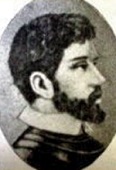
On Jan. 25, 1576 attracted by the silver mines of Cambambe, the Portuguese colonize Angola in Africa, and found the port city of Luanda (São Paulo da Assunção de Loanda) (modern-day pop. 2.8M) with 400 settlers (100 families) and 400 soldiers under Paulo Dias de Novais (1510-89) - luanda take a little boat trip?


Rocking the suburbs, just like Michael did? Pushy Portugual goes too far, tries to reverse 7/11, and ends up zonking itself, letting Spain take it over? On Aug. 4, 1578 after ambitious king (since June 11, 1557) Sebastian I of Portugal (b. 1554) leads an expedition to Morocco to Christianize the Muslim Moors in alliance with deposed sultan al-Mutawakkil, his 20K-man army is drowned and he is KIA along with al-Mutawakkil at the Battle of the Three Kings (Alcacer Quibir) in Alcazar; since his body is never found, his subjects keep hoping for his return, calling him "the Desired"; Portugal begins its decline after his death; his regent and great-uncle Cardinal Henrique, the penultimate male prince of the legitimate line of the House of Braganza (Braganca) (founded 1442) becomes Henry (Henrique) I (1512-80), king #17 of zonked Portugal, which on his watch falls under Spanish control for 60 years; Abd al-Malik dies, and his brother Ahmad I al-Mansur the Victorious (El-Mansour Eddahbi) (1549-1603) becomes emir of Morocco (until Aug. 25, 1603), building the El Badi ("Marvelous") Grand Palace in Marrakesh and claiming the caliphate; Philip II of Spain orders the aged Duke of Alva on his last mission for the House of Hapsburg to conquer Portugal.
In 1579 Portuguese merchants set up a trading station in Bengal.




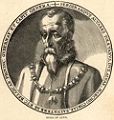
On Jan. 31, 1580 King-Cardinal Henry (Henrique) I (b. 1512) dies, leaving no heir (he wants to admit to?), and the Avis (Aviz) Dynasty in Portugal (founded 1385) ends (in with a Henrique, out with a Henrique?), causing the Portuguese secession crisis of 1580; in June old fart "Iron Duke" Fernando Alvarez (Álvarez) de Toledo y Pimentel, 3rd Duke of Alva (Alba) (1507-82) and a 40K-man army of Spanish troops along with German and Italian mercenaries land in Portugal, meeting a ragtag 8.5K-man Portuguese army along with 3K African slaves at the Aug. 25 Battle of Alcantara near Lisbon, which is captured on Aug. 27, after which Henry I is succeeded by Philip II (the Prudent) of Spain (1527-98) after six other less rich claimants are dealt with, esp. Duke John of Braganza (1543-83) (grandfather of Joao IV), and crowned next Mar. 25, founding the House of Hapsburg (Philippine Dynasty) in Portugal (ends Dec. 1, 1640), ruled by three Spanish Hapsburg kings named Philip, while the Spanish under the cruel-is-cool pain-no-problemo Duke of Alva crush all opposition; Philip II now rules the original empire in which the Sun never sets, taking the title of richest ruler in history (there's a crime in every fortune, to the nth power?); Ceuta reverts from Portugal to Spain; the annexation of Portugal vastly increases Spain's already formidable naval fleet.
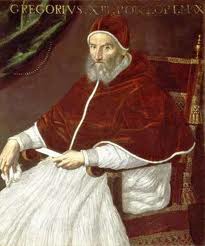
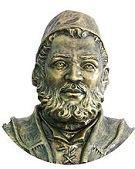



On Feb. 24, 1582 upon the recommendation of German Jesuit astronomer Christopher Clavius (1538-1612), Pope (since May 13, 1572) Gregory XIII (1502-85) issues the bull Inter Gravissimas, decreeing a changeover from the Julian Calendar to the Gregorian Calendar; 10 days (lost since Jan. 1, -46, when the Julian Calendar began) are to be dropped, so that Oct. 15 (Fri.) immediately follows Oct. 4, or Dec. 20 (Mon.) follows Dec. 9; the Papal States, Spain, Portugal, and Poland change in Oct., France, Holland, Belgium, and Scandinavia in Dec.; the Roman Catholic states of Germany and Switzerland adopt it in 1584, followed by Hungary in 1587; too bad, Protestant countries suspect a rat and refuse to change, and the Continental Protestant states hold out until 1700, and England and its colonies till 1752; Russia holds out until 1918, Greece until 1924, and non-Euro states don't adopt it until the 19th and 20th cents., Japan in 1873, Egypt in 1875, Turkey in 1926, and China in 1949; the figure for the length of the year from Copernicus' De Revolutionibus Orbium Coelestium is proposed but not used as the basis of the reform calendar; after a suggestion by Vatican librarian Topo Gigio, er, Aloysius Lilius (Luigi Lilio or Giglio) (1510-76), only century years (1600, 1700, etc.) with the century part itself evenly divisible by four (1600 but not 1700) are leap years, which causes three leap years to be taken out of each 400, trimming the avg. calendar year down quite fortunately to only about 26 sec. longer than the Earth's real orbital period, which will take 3,323 years to become 1 day out of synch; too bad, there should have been a 13-day discrepancy, not a 10-day one, causing the Phantom Time Hypothesis to be developed by Herbert Illig (1947-), Anatoly Fomenko (1945-), Uwe Topper (1940-) et al., that phony phantom centuries were manufactured during the Renaissance to create a nonexistent Dark Ages; Pope Gregory's new calendar for the Christian world changes the date of the new year from Apr. 1 to Jan. 1, and those who still celebrate New Year's Day on Apr. 1 begin to be known as April Fools.
In 1592 the Portuguese settle at Mombasa, Kenya on the E coast of Africa, and recognize the sultan of the coastal town of Malindi, who just captured it and moved there, moving their main base to Mombasa, after which Malindi goes feral.
In 1593 Ft. Jesus on Mombasa Island is founded by Philip I of Portugal to guard the port of Mombasa, Kenya; from the air it has the shape of a man.


On Sept. 13, 1598 to the great relief of the English and the Huguenots, after 50 days of intense pain Spanish king (since Jan. 16, 1556) Philip II (b. 1527) dies, covered with stinking, putrefying sores and with a lead coffin placed by his orders at his bedside, and his 20-y.-o. son Philip III (the Pious) (1578-1621) becomes king of Spain, plus (as Philip II) king of Portugal, Naples, Sicily, and the Netherlands (until Mar. 31, 1621); a weak pious whimp, he entrusts the conduct of public affairs to Francisco Gomez (Gómez) de Sandoval y Rojas, 1st Duke of Lerma (1553-1625) while he has fun with religious observances and court festivities and stays away from realities; meanwhile his ministers try to get Spain out of the European wars while it licks its stinking, putrefying wounds; the glory of Spain is never again what it once was, but the Spanish do a good job of hiding it for some time because it's only been a cent. since Columbus?
In 1603 Hernando Arias (Hernandarias) de Saavedra (1561-1634), Spanish gov. of Rio de la Plata in 1597-9 and 1602-9 ships some cattle and horses downstream to Asuncion, Paraguay, and they end up running wild, growing into large herds and becoming game for gauchos from Buenos Aires; meanwhile drought-stricken NE Brazil receives relief food from Philip III.
On Jan. 3-6, 1610 the Nossa Senhora da Graca Incident at the mouth of Nagasaki Bay in Japan sees samurai Arima clan junks attack the richly-laden Portuguese carrack Nossa Senhora da Graca (Madre de Deus) (known as the "black ship"), meeting fanatical resistance ending when Capt. Andre Pessoa sets the gunpowder store on fire, demolishing the ship and destroying the crew but denying them the cargo.
In 1610 a Portuguese settlement is founded at Cape Coast (Cabo Corso) 100 mi. W of Accra on the Gulf of Guinea, home of the Fante (Fanti) people.

On Dec. 1, 1640 after 60 years of living under Spanish rule, only to end up overtaxed and its colonies left unprotected, the Catalan Revolt (Reapers' War) begins in Catalonia (ends Nov. 7, 1659), supported by France, helping the Portuguese expel whimpy Philip IV and the Spanish, beginning the Portuguese Restoration War (ends Feb. 13, 1668); on Dec. 15 the duke of Braganza, leader of the patriotic party becomes Joao (John) IV (the Fortunate) (the Restorer) (1604-56), king of an independent Portugal (and Brazil) (until Nov. 6, 1656), founding the bragging Braganza Dynasty (ends Oct. 5, 1910), which goes on to kick Spanish and Dutch butt and win back their possessions in South Am.; hereafter all heirs to the Portuguese throne are given the bragging rights to the title of duke of Braganza; too bad, Portugal has to put its military priorities on defending its frontiers with Spain, allowing the pesky Dutch to seize many of its colonial possessions, until the Thirty Years' War begins in 1648. King Joao IV of Portugal prohibits the sale of Cubeb (Java pepper) to promote the black pepper (Piper nigrum).
And the Dutch become the Spice Girls of Europe? On Jan. 14, 1641 with help from the sultan of Johore, the Dutch take possession of the Portuguese fort of Melaka (Malacca) (held since 1511), allowing them to control the tea trade; meanwhile after years of bloodshed the Dutch oust the Chinese from Formosa (Taiwan) to control the Sika deer trade, and rule it until 1661.
On Mar. 11, 1641 the Battle of Mborore (Mbororé) near modern-day Panambi sees a combined force of Guarani Indians and Jesuits defeat slave-raiding Paulistas (mamelucos) (bandeirantes) from Sao Paulo in a battle on the Uruguay River.
On June 6, 1641 Spain officially loses Portugal.

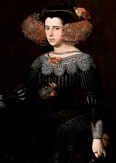
On Nov. 6, 1656 king (since Dec. 1, 1640) Joao IV the Restorer (b. 1604) dies, and his son Afonso VI (the Victorious) (1643-83) becomes Braganza king #2 of Inquisition-loving Portugal (until Sept. 12, 1683), with his mother Luisa Maria Francisca de Guzman (Guzmán) y Sandoval of Medina-Sodonia (1613-66) as regent until 1662.
On Nov. 7, 1659 the badass Peace (Treaty) of the Pyrenees, signed on Pheasant Island in the Bidassoa River by Cardinal Mazarin for Louis XIV of France and Don Luis de Haro for Philip IV of Spain ends the Catalan Revolt (begun 1640) and the Franco-Spanish War between France and Spain begun in 1635 by Louis XII and Ferdinand the Catholic over Italy, with humilitating terms for Spain; Spain cedes most of Artois and parts of Flanders, Hainault, and Luxembourg, plus Roussillon and part of Cerdanya, making receding the Spanish border with France to the Pyrenees; the terms incl. a marriage between Louis XIV and Philip IV's daughter Infanta (Louis XIV's cousin) Maria Theresa (Marie Theresa) (Maria Teresa) (Marie-Therese) (1638-83) along with a renunciation of her claims to the Spanish throne, which happens next year; she goes on to lose five of her six children in childhood and die at age 44 from an abscess on her arm; her grandson Philip V inherits the Spanish throne in 1700, founding the Spanish branch of the House of Bourbon, which rules untl ?.
On May 11, 1661 the marriage treaty of Charles II of England and Catherine of Braganza, daughter of John IV of Portugal gives the Seven Islands of Bombay to England; on Mar. 27, 1668 a Royal Charter leases them to the English East India Co. for £10/year, causing the pop. to zoom from 10K this year to 60K in 1675.

On May 21, 1662 I'm-too-sexy-for-my-hat Charles II of England marries unpopular Roman Catholic Catherine of Braganza (1638-1705), daughter of King Joao (John) IV of Portugal, who arrived in Portsmouth, England on May 13/14 wearing Portuguese dress; the public service in the chapel of Domus Dei is Anglican, the secret one Roman Catholic; her dowry of £300K is sweetened by the ports of Tangiers (under Moorish control) and Bombay, as well as free trade with a number of Portuguese possessions; on Sept. 30 they enter London with a large procession incl. Portuguese bagpipe players, meeting matchmaker Henrietta Maria, the Queen Mother, who wants her charms to tame him, only to see him continue hooking up with his mistresses, aided by her Old Maid status (23-y.-o.) and three miscarriages; she goes on to introduce Portuguese goods to the court incl. cane, lacquer, cotton, and porcelain, hooking Charles II on tea and causing him to introduce it to the English court; meanwhile Afonso V of Portugal (b. 1643) puts away his mother Luisa de Guzman (also the mother of Catherine of Braganza), and assumes his reign; too bad, he is partially paralyzed and mentally unstable, causing his brother Peter II to plot to put him away, which he does in Jan. 1668, banishing him to the Azores then Sintra for life (Sept. 12, 1683) and ruling as regent.
In Aug. 1662 the British Brigade for Portugal is raised by Frederick Schomberg, 1st Duke of Schomberg, fighting until mid-1668.
On May 22, 1663 after overrunning S Portugal, Spanish troops under Don John of Austria the Younger, son of Philip IV take Evora (Évora), threatening Lisbon 84 mi. to the W.
On June 8, 1663 the Battle of Ameixial (Estremoz) near Santa Vitoria do Ameixial 6 mi. NW of Estremoz, Portugal is a V for 17K Portuguese troops under the Count of Mertola and the Count of Ericeira over 18.5K Spanish troops under Don John of Austria, who lose 8K casualties, incl. Don John's standard and all their artillery and baggage, and are forced to retreat to Badajoz, after which the 3.7K-man Spanish garrison of Evora capitulates on June 24.
On Feb. 13, 1668 the Treaty of Lisbon between Queeen Mariana of Austria (2nd wife of late Philip IV) in the name of her young son Carlos II of Spain, and prince-regent Peter II of Portugal, with the mediation of Edward Montagu, 1st Earl of Sandwich sees Spain recognize Portugal's new ruling dynasty, the House of Braganza, ending the Portuguese Restoration War (begun 1640).
In 1677 France takes the island of Goree (Gorée) (Dutch "Goedereede" = good roadstead) off the coast of Cape Verde Peninsula from the Portuguese, becoming the start of the city of Dakar, Senegal (modern-day pop. 1.1M/2.4M), westermost city on the African mainland and the Old World.

On Sept. 12, 1683 cloistered king (since Nov. 6, 1656) Afonso VI (b. 1643) dies in Sintra, and his brother Pedro (Peter) II (1648-1706) (regent since Jan. 1668) becomes king of Portugal and the Algarves (until Dec. 9, 1706).
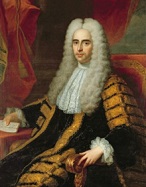
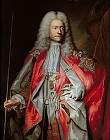

In May 1703 after English naval Vs against Spain permit England to detach Portugal from its French alliance, English ambassador John Methuen (1650-1706) negotiates the two Methuen Treaties, the first a 4-sided treaty, negotiated by Methuen with the help of his son Sir Paul Methuen (1672-1757) for England, Karl Ernst, Graf von Waldstein for HRE Joseph I, Franciscus van Shonenberg (AKA Jacob Abraham Belmonte) (a Marrano) for the United Provinces, and King Pedro II for Portugal, establishing an offensive-defensive alliance between Britain and Portugal, and promising to send the emperor's son Archduke Charles (later HRE Charles VI) to Portugal with land forces to win the crown of Spain, along with naval protection of the Portuguese coast against French and Spanish attack, followed by the 2nd on Dec. 27 with John Methuen signing for England, and Manuel Teles da Silva, 3rd Marquis de Alegrete (1682-1736) signing for Portugal, giving Portuguese (port) wines (grown in the Douro (Duero) River Valley in N Portugal and shipped in rabelo boats the Atlantic port of Porto) a one-third break on English duties in return for Portugal agreeing to import all its woolens from England duty-free, which, combined with the war with France depriving English drinkers of French wine causes the popularity of Portuguese port wine in England to zoom (not just for Whigs anymore?); meanwhile the Portuguese renounce manufacturing (except porcelain) in order to guarantee the security of Brazil, losing the Industrial Rev.?; too bad, while returning from Lisbon, Waldstein is captured at sea by the French, and exchanged a year later for Villeroi, who was captured in Italy by Prince Eugene.

On Dec. 9, 1706 king (since Sept. 12, 1683) Pedro II (b. 1648) dies, and his son Joao (John) V "the Magnificent" (1689-1750) becomes Braganza king of Portugal (until July 31, 1750), beginning a 44-year reign as the gold flows in from Brazil, allying with England in the War of the Spanish Succession and raising Portugal's prestige, aggressively expanding in the Americas and India, becoming known as the Portuguese Sun King.
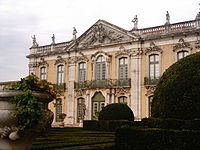
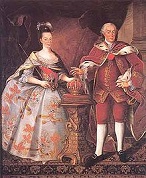
In 1747 after marrying Queen Maria I, the Palace of Queluz in Qeluz, Sintra (near Lisbon), Portugal is begun by Portuguese architect Mateus Vicente de Oliveira (1706-86) as a summer retreat for Dom Pedro (Peter III) of Braganza as an attempt to rival the Escorial Place in Spain, becoming one of the last great Rococo bldgs. in Europe, known as the Portuguese Versailles; after Dom Pedro's death in 1786, his consort Queen Maria I goes mad, and she is confined in the Pavilion (Pousada) of Dona Maria (finished 1792), designed by architect Miguel Caetano de Sousa (1738-1802).


On July 31, 1750 high-living (but generous to the Church) king (since Dec. 9, 1706) Joao V the Magnanimous, the Portuguese Sun King (b. 1689) dies after obtaining the title "Most Faithful King" from Pope Benedict XIV, and his religiously liberal son Joseph (Jose) I Emanuel (the Reformer) (1714-77) becomes king of Portugal (until Feb. 24, 1777), devoting himself to hunting and the opera, collecting one of the largest collections of scores in Europe; on Aug. 2 finance minister Sebastiao Jose (Sebastião José) de Melo, 1st Marquis of Pombal (1699-1782) becomes secy. of state for internal affairs (until Mar. 4, 1777) and for foreign affairs and war (until May 6, 1756), becoming the virtual ruler of the country, going on to attempt to bring down the Jesuits and secularize the country, claiming allegiance to the ideas of the Enlightenment while really enhancing state power, incl. increasing censorship, curtailing individual liberties, and pushing colonial expansion?; Portugal signs a treaty with Spain on South Am.
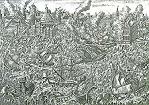
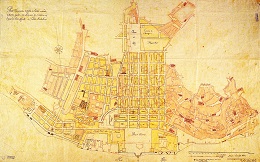

On Nov. 1, 1755 (Sat.) (All Saints' Day) (9:40 a.m.) the 9.0 Great Lisbon Earthquake followed by a tsunami and fires kills 10K-100K, bringing out the religious prophets who call it divine retribution for Portugal's sins; the earthquake causes King Joseph I to develop severe claustrophoba, causing him to move the royal court to a tent complex in Ajuda; Portuguese PM (secy. of state for internal and foreign affairs) (since Aug. 2, 1750) Sebastiao Jose (Sebastião José) de Carvalho e Melo, 1st Marquis of Pombal, 1st Count of Oeiras (1699-1782) rebuilds Lisbon (modern-day Lisbon Baixa) laid out in rectangular patterns, becoming known as the Pombaline Architectural Style, featuring prefabricated bldg. methods and other anti-seismic design features incl. a forest of buried poles, inter-terrace walls built higher than roof timbers to reduce the spread of fire, and the symmetrical wood lattice Pombaline cage (gaiola) to distribute earthquake force, with army troops marched around town to test the new bldgs.' strength.
In Jan. 1762 Spain enters the Seven Years' War on the side of France, just in time to share in France's defeat.
In May 1762 Spain invades Portugal.


On Feb. 10, 1763 after House of Commons leader (since 1762) Sir Henry Fox bribes, intimidates and persuades the House to approve it (and is raised to the peerage for it, becoming 1st Baron Holland), the 1763 Treaty of Paris between Britain, France, Spain and Portugal, negotiated for France by foreign minister Cesar Gabriel de Choiseul, Duc de Praslin (1712-85) ends the French and Indian War along with the Seven Years' War (begun 1756), giving Britain's ally Frederick II the Great of Prussia a V; "Half a continent... changed hands at the scratch of a pen" (Francis Parkman); French imperialist dreams are dashed bigtime, and in return for the #1 sugar island of Guadalupe, France cedes to Britain all claims to Acadia, Canada (Quebec), Cape Breton, Louisiana E of the Mighty Mississippi except Orleans Island, plus all of India; Spain cedes Florida to Britain in return for British evacuation of Havana (to prevent Britain from going on to swallow up Mexico), and receives Louisiana from France, which is resisted locally by French colonists; St. Vincent Island is ceded to Britain (until 1779), along with Dominica Island; displaced Acadians begin to head for Louisiana, where they become known as Cajuns, while Spanish colonists leave Florida for Havana, and British colonists with their slaves head for Florida; Spain regains Cuba and the Philippines, while Portugal regains Colonia and Rio Grande do Sul; the Spanish begin transforming Havana into the most heavily fortified city in the New World, building the Fortress of San Carlos de la Cabana over 11 years, becoming the biggest Spanish fortification in the New World, equipped with cannons made in Barcelona; France is allowed to keep a trading post in Bengal, India, and to keep Guadeloupe Martinique, Belle Isle, Maria Galante and St. Lucia, and also to have fishing rights on the Newfoundland Banks, with the small islands of St. Pierre and Miquelon for fish curing, otherwise the French empire in America is, er, history?; Britain keeps one of the French posts on the coast of Guinea and loses the other; Britain recovers Minorca; France is bankrupt, and its navy a wreck, but war secy. (Cesar's cousin) Etienne Francois, Duc de Choiseul (1719-85) predicts that the British Am. colonies will rebel, and begins rebuilding the French navy to take advantage of it?; Britain is now numero uno, but the British Parliament then proceeds to fart away its American colonies via a series of dumbass Acts?; Lord Newcastle tries to organize an opposition to the Treaty of Paris and fails, finding that all who vote against it soon lose any offices or pensions they hold from the crown as punishment; by using this power the king gradually builds up a group in the House of Commons known as the King's Friends - if you look like a tree he'll talk to you?
In 1765 the Portuguese found the town of Bissau at the mouth of the Geba River in W Africa as a fort.


On Feb. 24, 1777 king (since July 31, 1750) Joseph I the Reformer (b. 1714) dies, and his daughter Maria I (the Pious) (the Mad) (1734-1816) becomes ruler and first undisputed queen regnant of Portugal (until Dec. 16, 1815) as wife of his addlepated brother Pedro (Peter) III (1717-86) (until May 25, 1786); Spain and Portugal settle their disputes concerning their South Am. colonies, causing Brazil to be elevated from a colony to a kingdom; too bad, about the time of Peter III's death she too becomes addlepated, getting worse after her eldest son dies of smallpox in 1791, and in Feb. 1792 she is declared insane (porphyria?), causing her son Joao (John) VI to become prince regent in 1799.
On Oct. 1, 1777 the First Treaty of San Ildefonso between Spain and Portugal wrests Banda Oriental (East Side) (Uruguay) from Portugal, giving Colonia and other disputed Portuguese territory on the left bank of the Rio de la Plata to Spain, with a Spanish viceroy ruling from Buenos Aires (until 1814); in return Spain cedes the Amazon Basin to Portugal; Spain also gets the island of Fernando Po and African coastal territories between the Niger and Ogoue River mouths.

On Feb. 10, 1792 Portuguese queen (since Feb. 24, 1777) Maria I (b. 1734) is declared insane by 17 physicians, and her son Joao VI "the Clement" (1767-1826) begins to rule in her name, being officially declared regent in 1799 until her death on Mar. 20, 1816 - nothing takes care of you like state farm?
On Oct. 1, 1800 under pressure from Napoleon, Spain cedes Louisiana (La.) to France by the secret Third Treaty of San Ildefonso (1777, 1796), with France to take control in Nov. 1803, with Spain gaining Tuscany; the treaty also settles territorial disputes between Portugal and Spain over the Rio de Plata region; too bad, it doesn't specify the boundaries of La., causing difficulties during the 1802 Louisiana Purchase.
On May 20-June 9, 1801 the War of the Oranges sees Spain declare war on Portugal after it refuses the demand of Spanish minister Manuel de Godoy to enter into an alliance with France against its ally (since 1343) Britain as well as cede most of its territory; in Apr. French troops invade, and on May 20 they are joined by Spanish troops, taking the town of Olivenza (Olivenca) near the border, after which Godoy picks oranges at nearby Elvas and sends them to the queen of Spain with a message that he will now head toward Lisbon, after which Portugal folds, signing the Treaty of Badajoz on June 6, ceding Olivenza, Almeida and other border fortresses to Spain, and closing all ports to the British; on Sept. 29 John VI of Portugal also signs the 1801 Treaty of Madrid, agreeing to pay France a 20M franc indemnity and cede half of Guyana in N South Am., which becomes French Guiana.

In July 1801 British Col. Sir William Henry Clinton (1769-1846) leads a force of 3.5K men to the Portuguese island of Madeira SW or Portugal to forestall any French or Spanish attack; they are withdrawn next Mar. after the signing of the Treaty of Amiens.


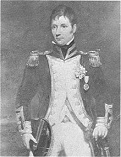
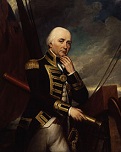
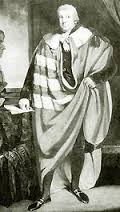
Hands across the water, hands across the sky, or, Bloody Trick or Treat, What What? England gets its world-class naval hero? On Oct. 21, 1805 (Mon.) after the French fleet under vice-adm. Pierre Charles Jean Baptiste Silvestre de Villeneuve (1763-1806) breaks out of Toulon and eludes the British fleet under vice-adm. Horatio Nelson, 1st Viscount Nelson, 1st Duke of Bronte (b. 1758), then takes refuge in Cadiz and receives reinforcements from the Spanish navy, bringing them up to 33 ships (vs. 27 for the British), and slowpoke Nelson catches up and blockades it, the French break out of the harbor again, beginning the naval Battle of (Cape) Trafalgar (Britain's greatest sea battle?) between Gibraltar and Cape Roche outside Cadiz, resulting in a decisive V for the British, dashing Napoleon's hopes of invading England and establishing British sea supremacy for the next 150 years; Adm. Nelson, aboard his flagship HMS Victory leads the charge that breaks through the center of the French line between Bucentaure and Redoubtable, capturing 10 French and 11 Spanish ships, with no British ships lost, and a total of 1,666 British casualties (458 KIA and 1,208 wounded) vs. 13,781 French-Spanish casualties, incl. 3K POWs drowned in a sorm after the battle; Victory suffers 57 KIA and 102 wounded, with Redoutable attempting to board her but suffering a devastating broadside from the 98-gun HMS Temeraire, commanded by Adm. Sir Eliab Harvey (1758-1830), known for recklessly gambling his family fortune in London, who also forces the surrender of the Fougueux, causing him to create the family motto "Redoubtable and Fougueux"; Nelson signals the famous message "England expects that every man will do his duty", and is wounded several times by French sharpshooters before meeting his death as the battle ends from a musket ball from Redoubtable that enters his left shoulder and lodges in his spine, dying at 4:30 p.m. and giving a last order to anchor the fleet, which is countermanded by his 2nd in command vice-adm. of the blue Cuthbert Collingwood (1748-1810), who succeeds Nelson as CIC, transferring his flag from the damaged Royal Sovereign to the Euryalus, attempting to tow damaged vessels until a storm wrecks many prizes incl. Redoubtable on the rocky shore while others are destroyed to prevent capture, getting Collingwood a promotion on Nov. 9 to vice-adm. of the red along with a peerage as Baron Collingwood of Northumberland, along with a £2K/year pension and his 3rd gold medal from Parliament (joining Nelson and Sir Edward Berry); Victory is towed by HMS Neptune to Gibraltar for repairs, then flies a black sail on its return voyage to England; Villenueve is captured by the English, and returned to France next year; in Nov. Adm. Horatio Nelson's elder brother William Nelson (1757-1835) is created 1st Earl Nelson of Trafalgar; Portugal restores relations with its old ally Britain, causing France to declare the 1801 Treaty of Badajoz canceled, leading to the 1807-10 Peninsular War.
On May 30, 1806 Napoleon I issues a decree calling for an Assembly of Jewish Notables, and on July 23 the first meeting of the Sanhedrin since the Roman destruction of Jerusalem in 70 C.E. is held in Paris at the City Hall, consisting of 111 Jewish reps. from all the depts. of France and N Italy, which pisses-off Third Coalition partners Russia, Austria, Prussia, and England, causing Napoleon on Nov. 29 after his V at Jena to give a speech in Posen making Judaism the official fifth column, er, third religion of France, proclaiming the long-disputed loyalty of the 40K Jews in France (1K in Paris) and making them into French citizens, but also depriving some Jews of their economic freedom; the anti-Semitic pressure on him only intensifies; the French appoint Mainz archbishop-elector (since 1802) Karl Theodor Anton Maria von Dalberg (1744-1817) as grand duke of Frankfurt on Main, and he orders the Jews to be given equal rights and abolishes the old law forbidding them from walking on the Anlagen main ring road, which doesn't stop the town council from issuing new regs in 1807 attempting to reestablish the ghetto, causing Dalberg to issue his "highest regulation for the equality of civil rights of the Jewish muncipality" in 1811, abolishing the requirement for Jews to live in the ghetto or pay special taxes, after the Jewish community pays a lump sum of 440K guilders; thanks to Napoleon, Portugal gives Jews their freedom in 1811, followed by Prussia in 1812, Holland in 1830, Sweden in 1834, and Switzerland in 1838; after Nappy's fall in 1815, Prussia reneges, along with France, until 1830, when it restores Nappy's laws - friends are friends but rules are rules?


On Oct. 27, 1807 the Peninsular War (ends Apr. 17, 1814) begins after France gets pissed-off at Portugal for not joining the Continental Blockade, and in early Nov. 1807 it occupies Portugal, causing King Joao VI (prince regent) to flee on Nov. 29 with mad screaming Maria I and the entire Braganza royal family incl. its 15K hangers-on in advance of French armies and transfer the Portuguese Braganza Court next Jan. to Salvador da Bahia, soon bowing to pressure and signing a commercial law opening commerce between Brazil and friendly nations esp. Britain; meanwhile in Sept. the Russian fleet under adm. Dmitri Nikolayevich Senyavin (1763-1831) leaves, arriving in Lisbon on Oct. 30, and the British navy moves in and blockades Lisbon, starting the Anglo-Russian War (ends July 18, 1812); after French forces under gen. Jean-Andoche Junot, 1st Duke of Abrantes (1771-1813) overrun Lisbon, Senyavin's fleet is caught in the middle, causing Senyavin to turn diplomat in an effort to save it, starting with ignoring orders from Napoleon via the Russian embassy in Paris to replace British officers on some of his ships with French ones; Nappy's ultimate plan for Portugal is to split it into three sections, with N Portugal from the Douro to the Minho becoming the Kingdom of Northern Lusitania, headed by Carlo Lodovico II of Etruria (1799-1883), the Alentejo Province and Kingdom of the Algarve merged into the Principality of the Algarves, headed by Spanish PM Manuel de Godoy, and the remaining portion directly ruled by France.

On Apr. 14, 1808 the Battle of Bayonne is a D for new Spanish king Joseph Bonaparte (until 1813), elder brother of Napoleon, who is transferred from Naples to be crowned on June 6, while Napoleon's fashionplate brother-in-law Joachim Murat (1767-1815) becomes king of Naples (until 1815); Ferdinand VIII is imprisoned in France; on Sept. 25 an opposition govt. is formed in Cadiz, which recognizes Ferdinand VIII as true king; in Dec. Napoleon abolishes the Inquisition in Spain and Italy by decree, after which it keeps popping up again until 1834.

On July 12, 1808 British Lt. Gen. Arthur Wellesley (1769-1852) leaves Cork, Ireland with 9K men for the Iberian Peninsula to fight in the Peninsular War, rendezvousing with 5K troops from Gibraltar.
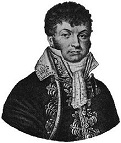
On July 29, 1808 the Battle of Evora (Évora) sees an outnumbered Portuguese-Spanish force of 2.5K incl. peasants trying to defend the town routed by a French-Spanish div. under Gen. Louis Henri "One-Hand" (Maneta) Loison (1771-1816), who then sack the town, indiscriminately slaughtering 8K, while losing only 290.



On Aug. 16, 1808 after the Spanish revolt and the British come to their aid, joining the Peninsular War, the French begin losing and retreating, starting with the Battle of Rolica, followed by the Battle of Cadaval Aug. 17, and the Battle of Vimeiro on Aug. 21, hich are all Vs for the Anglo-Portuguese army under Gen. Arthur Wellesley over the French under Gen. Jean-Andoche Junot; too bad, on Aug. 30 the Convention of Cintra, signed in the Palace of Queluz allows the the French to evacuate Portugal, leaving the trapped Russian fleet of adm. Dmitry Senyavin to face a larger British force plus coastal artillery, which Senyavin answers by threatening to blow up his ships and fire Lisbon if attacked, resulting in British adm. Sir Charles Cotton, 5th Baronet (1753-1812) signing a makeshift convention allowing them to leave under British escort for Portsmouth, England on Aug. 31, with Senyavin given supreme command of the "joint Anglo-Russian fleet", but when they arrive on Sept. 27 the British Admiralty and the lord mayor of London get pissed-off at seeing their flags, causing them to be detained until winter so they can't return to the Baltic, after which the half-starved fleet slinks off to Riga next Aug. 5, arriving on Sept. 9, after which Senyavin is forced into retirement (until 1825); meanwhile Sir George Scovell (1774-1861) of the British Army breaks the Grand (Great) Cipher of Napoleon, helping tilt the odds against the French; the London Times sends German-educated Henry Crabb Robinson (1775-1867) to Spain to cover the war, becoming the first war correspondent and keeping a cool diary.

Secure our supply of port wine first, then get serious? On Mar. 10-12, 1809 after getting off to a slow start in Galicia, the French win the Siege of Chaves in Portugal, followed on Mar. 20 by the Battle of Braga, then force a passage on the Ave River on Mar. 25-26, arriving at Oporto with 16K of his original 22K men, finding that 6 mi. of fortifications have been built for its 30K defenders, only 5K of which are experienced soldiers; on Mar. 21-25 the Portuguese retake Chaves; on Mar. 29 the First Battle of Oporto is a V for Marshal Soult; meanwhile in Mar. another French army under Marshal Claude Victor-Perrin, Duc de Belluno (1764-1841) invades Estremadura; too bad, Arthur Wellesley returns in Apr., and on May 12 he and his 25K men defeat Soul and his 20K men at the Second Battle of Oporto (Porto) (the Douro River), causing Soult to retreat N over mountainous terrain, losing several thousand men and most of their transport, after which Wellesley turns S to take care of Marshal Victor on July 27-28 at the bloody inconclusive (tactical Anglo-Spanish V, strategic French V) Battle of Talavera 70 mi. SW of Madrid, protecting Portugal from further invasion; big man Arthur Wellesley is created duke of Wellington, and his brother is created marquis Wellesley and appointed foreign secy.
On Apr. 22, 1809 Sir Arthur Wellesley returns to Portugal to command Portuguese forces.

On July 21, 1810 after Nice, Italy-born French marshal Andre (Andrea) Massena (1758-1817), "the dear child of Victory" (greatest gen. in France after Napoleon) is transferred to Spain (taking his mistress with him dressed as a dragoon), and takes over the 65K-man French army, he invades Portugal - another sock hop?
There's a place called Hidden Valley? Keep Santa smiling and waving? On Sept. 27, 1810 after French marshal Andre Massena chases the outnumbered British-Portuguese army (25K of each) led by Sir Arthur Wellesley (1769-1852) (later 1st Duke of Wellington) towards Portugal, he is unexpectedly defeated at the Battle of Bussaco (4.5K French vs. 1.25K Anglo-Portuguese casualties) after the Connaught Rangers (Devil's Own) (founded 1793) save the day; after the French regroup, they chase the Brits to a few mi. from Lisbon, where they hide behind the secretly-built (since Nov. 1809) Lines of Torres Vedras (built to defend Lisbon) (until Sept. 1810), and the French reach their zenith in Portugal; too bad, they can't breach the lines, and the onset of winter causes them to begin starving.

On May 3-5, 1811 the Battle of Fuentes de Onoro sees the British-Portuguese army under Gen. Arthur Wellesley defeat the French under Gen. Massena, causing the Peninsular War to decisively turn against them, and the French invasion of Portugal to begin turning into a rout; on May 6 Wellesley sieges Badajoz; on May 8 Suchet sieges Tarragona; on May 10 the French garrison breaks out of Badajoz, causing the Brits to raze their siege on May 12; on May 16 the Battle of Albuhera (Albuera) is a V (push?) for the French and their Vistula Uhlan Regiment against the combined forces of Britain, Spain, and Portugal (a sobering lesson to Napoleon about his forces' limitations?), after which Wellesley resumes his siege of Badjoz on May 25, then begins retreating into Portugal on June 27; meanwhile in July French gen. Auguste Marmont (1774-1852) is hastily summoned to replace Gen. Massena in N Spain.
On May 8, 1812 after Arthur Welleseley enters Madrid, a nat. assembly elected in Cadiz, Spain promulgates the new democratic 1812 Constitution; in July Wellesley begins a retreat to Portugal.
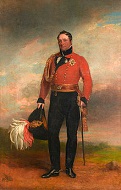
On May 18-19, 1812 the Battle of Almaraz in Spain sees an Anglo-Portuguese army under British Gen. Lt. Gen. Rowland Hill (1772-1842) destroy a French pontoon bridge over the Tagus River, keeping French forces separated.
On June 17, 1812 the British under Gen. Arthur Wellesley siege Salamanca, Spain; on July 22 after several weeks facing each other off, the Battle of Salamanca (Battle of the Arapiles) is a V for the Brits and Portuguese under Wellesley over the French forces of Marshal Auguste Marmont, who is gravely wounded in the right arm and side and retires to France; meanwhile British Gen. Rowland Hill and his 18-man army protect Badajoz.
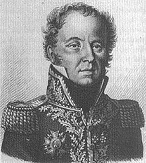
On June 21, 1813 82K allies under the Arthur Wellesley, 1st marquess of Wellington decisively defeat 60K French troops under Gen. Jourdan at the naval Battle of Vittoria (Vitoria) in Spain, then on July 7-Sept. 8 9,750 British and Portuguese troops under Thomas Graham siege San Sebastian in N Spain, defended by 3,380 troops under French Gen. Louis Emmanuel Rey (1768-1846), sacking and burning the town before invading S France, causing Joseph Bonaparte to return to his estate in France without resigning; meanwhile French marshal Suchet is driven out of Valencia and Barcelona.
On Nov. 10, 1813 after 80K British, Portuguese, and Spanish troops (incl. 20K green Spanish troops) under Arthur Wellesley and Sir John Hamilton chase 60K French troops under Marshal Nicolas Jean de Dieu-Soult from San Sebastian to a defense line on the Nivelle River in France, manning a 20-mi.-long line from the Roncesvalles Pass to the Atlantic Ocean, spreading them thin, the Battle of Nivelle on the Nivelle River in France is a V for the Allies under Arthur Wellesley and Sir John Hamilton over the French under Gen. Nicolas Jean de Dieu-Soult, with 2,2450 British vs. 4,351 French casualties.
A colony rules its former mother country? In 1815 Brazil becomes an independent kingdom equal to Portugal, with Prince Regent Joao (John) VI (Dom John) ruling both countries from Rio de Janeiro, where he was driven into exile by the French during the Napoleonic Wars; on Dec. 16 Mad Maria I is proclaimed queen of the United Kingdom of Portugal, Brazil, and the Algarves; after Nappy is defeated at the Battle of Waterloo, Maria I and her family remain in Brazil.

On Mar. 20, 1816 bananas queen (1777-1815) Maria I the Mad (b. 1734) dies, and her son Joao (John) VI (the Clement) (1767-1826) (regent since 1792) becomes king of Portugal (until Sept. 7, 1822), going on to see Spain, France, and Britain intervene in Portugal's affairs, his wife Carlota Joaquina of Spain conspire against him repeatedly, his son Dom Pedro take Brazil independent, and his other son Dom Miguel lead a rebellion seeking to depose him; his whale-like obesity does nothing to garner respect?

On Aug. 24, 1820 the Portuguese Liberal Rev. of 1820 begins when Portuguese troops stimulated by the Spanish rev. mutiny in Oporto and Lisbon, and the rev. quickly and peacefully spreads throughout the country; Portuguese Romantic poet Joao Baptista da Silva Leitao, Visconde de Almeida-Garrett (1799-1854) is exiled after participating in the liberal revolt (until 1832), going on to hobnob with French Romantics and Sir Walter Scott.
In Sept. 1820 Portuguese from Brazil finish conquering Uruguay (begun 1816), annexing the Banda Oriental to Brazil as the Cisplatine State; Gen. Jose Gervasio Artigas flees to Paraguay after issuing the soundbyte "I will not sell the rich heritage of Orientals at the low price of necessity", and drops out of sight until his death 30 years later.
On Mar. 31, 1821 the Portuguese Inquisition (founded May 23, 1536) is disbanded.
In 1821 Gen. Jose Francisco Morazan (Morazán) Quezada (1799-1842) becomes secy.-gen. of Honduras, going on to dominate Central Am. with his brilliant military strategies.
In 1821 Gen. Martin Rodriguez becomes gov. of Buenos Aires, and names extreme liberal Bernardino de la Trinidad Gonzalez Rivadavia y Rivadiva (1780-1845) as PM (until Feb. 8, 1826), working with British merchants and helping create a class of estancieros (big ranchers) while forcing Indian peasants and gauchos to work for them.

On Sept. 7, 1822 Joao VI's son Dom Pedro resists Portuguese pressure to reduce Brazil to colonial status, and declares independence, becoming its first emperor Pedro I (1798-1834) on Oct. 12 (until Apr. 7, 1831); a good horseman and musician, he is popular with the people.
In 1822 the 1822 Portuguese Constitution, modeled after the U.S. Constitution is proclaimed, causing Joao VI to return from Brazil next year, leaving his eldest son Dom Pedro as regent of Brazil, swearing fidelity to the new constitution, while his other son Dom Miguel plots against it - Prince Metternich was right?
On May 27, 1823 the Villafrancada erupts in the Villa Franca de Xira near Lisbon, Portugal, headed by Brig. Gen. Ferreira Sampaio and joined by Dom Miguel de Braganca and his mother the queen declares support for an absolutist monarchy and the ditching of the 1822 constitution, demanding the abdication of the king, who marches on the town and causes them all to submit, but dismisses the Cortes, forcing many liberals into exile.
On Apr. 29-30, 1824 under the pretext that a Masonic conspiracy exists to assassinate the king, Dom Miguel de Braganca (Bragança) (1802-66), youngest son of Joao VI stages the Abrilada Coup in Portugal, causing daddy to take refuge aboard British man-of-war Windsor Castle and proclaim his son a traitor; Dom Miguel is forced to yield and leave Portugal, and Joao VI is reinstated in power, restoring the liberal constitution.
In 1824 German emigration to Brazil begins - the original Boys from Brazil?



On Mar. 10, 1826 king (1816-22) Joao VI (b. 1767) dies, and is succeeded by his son Dom Pedro of Brazil as Pedro (Peter) IV Alcantara (the Liberator) (1798-1834), who promulgates a moderately liberal constitution, with a parliament and guaranteed free primary education, then abdicates the Portuguese throne on May 2 in favor of his young daughter Maria II da Gloria (1819-53), with his brother (her uncle) Dom Miguel de Braganca (Miguel I) (1802-66) as regent, who marries her by proxy, anticipating her coming of age - I'm putting on a white tie and a top hat, and polishing my cane?

On July 4, 1828 after the British force in Portugal withdraws after making Dom Miguel promise to respect the liberal constitution, and as soon as the suckers are gone he stages a palace coup, abolishes the liberal 1822 constitution, and on July 11 has himself proclaimed as King Miguel I (1802-66) (until May 26, 1834); Maria II da Gloria flees to London, obtaining the support of Dom Pedro of Brazil to fight for her restoration, and the Miguelite (Liberal) Wars (Portuguese Civil War) (War of the Two Brothers) begin (end 1834).

On Apr. 7, 1831 after being harassed by his parliament, Brazilian king (since 1822) Pedro I abdicates in favor of his 5-y.-o. son Pedro (Peter) II (the Magnanimous) (1825-91) (until Nov. 15, 1889), then sails to Portugal to fight his usurper brother Dom Miguel and restore Maria II da Gloria.
In July 1833 Dom Pedro (Pedro I) arrives in Lisbon and defeats Dom Miguel (Miguel I), who flees for Austria, and Maria II da Gloria is restored as queen, along with liberal govt., with Pedro as regent, going on to appropriate Church property and dismiss clergy; poet Visconde de Almeida-Garrett, who returned from exile last year to oust Pedro becomes interior minister, followed by Cortes member, going on to become the grand old man of Portuguese theater.

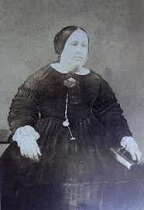
On May 26, 1834 Miguel I of Portugal is finally defeated, ending the Miguelite Wars (begun 1828), and he abdicates, leaving Maria II da Gloria (1819-53) as sole ruler (until Nov. 15, 1853); she is acclaimed on Sept. 20. On May 28 Portugal abolishes monasteries, and also abolishes trade corporations and guilds to allow free trade; meanwhile radicals call a constituent assembly to write yet another constitution. On Sept. 24 king (since Oct. 12, 1822) Pedro I (b. 1798) dies in Lisbon of TB after putting his 15-y.-o. daughter Maria II de Gloria back on the Portuguese throne; British Foreign Secy. Lord Palmerston negotiates the Quadruple Alliance between England, France, Spain, and Portugal to support Queen Maria II of Portugal and Queen Isabella of Spain against the pretenders to their thrones - now if anybody out there can sing or dance or tell jokes?
On Aug. 19, 1837 Peter IV's 1826 moderate charter is restored in Portugal.
In 1851 the Colorados conclude an alliance with Brazil and the State of Entre Rios, which had revolted against the Argentine Confederation, then defeat Manuel Oribe and the Blancos, bringing Jose Fructuoso Rivera and the Colorados to power in Uruguay, with the Blancos continuing to challenge them for the rest of the cent., but never gaining control for long.

On Nov. 15, 1853 queen (since May 26, 1834) Maria II da Gloria (b. 1819) dies, and her eldest son Pedro (Peter) V de Alcantara (the Hopeful) (1837-61) becomes king of Portugal (until Nov. 11, 1861), going on to modernize Portugal incl. the govt. and infrastructure, building roads, railways, and telegraphs, and improving public health; too bad, after stopping the cholera outbreak of 1853-6, he and his brothers Joao and Fernando die of cholera in 1861, and he dies childless, leaving the throne to the remaining brother Luis I.
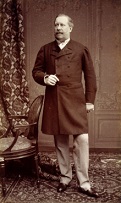
On Nov. 11, 1861 king (since Nov. 15, 1853) Pedro V (b. 1837) dies of cholera, and although in 1858 he married comely babe Stephanie of Hohenzollern-Sigmaringen (1837-59), she died a year later of diphtheria, leaving him childless, and his brother (2nd son of Maria II and Ferdinand II) Luis I "O Popular" (1838-89) becomes king of Portugal (until Oct. 19, 1889), having no political gifts and allowing the country to slide into stagnation and fall farther behind other W Euro nations, while coping with a series of Rotavist govts. (Liberals alternating with Conservatives) while he dabbles in vernacular poetry and oceanography, ruling for almost 30 years, collecting ocean specimens throughout the world and building the Aquario Vasco da Gama in Lisbon (opens 1898), becoming one of the first major aquariums.

In 1885 the Treaty of Berlin is signed, becoming the first to use the term "spheres of influence", meaning white Euro powers claiming to own black African areas (and their people?); Germany annexes Tanganyika and lets Britain have Zanzibar in exchange for Heligoland in the North Sea, and asserts rights to German East Africa, German Southwest Africa, Cameroon, and Togoland, sending explorer Gustav Nachtigal (b. 1834) as special commissioner to annex them (he dies on the return voyage on Apr. 20); Germany relinquishes its claims to Madagascar in favor of France, and Britain pledges not to interfere, dooming its independence, freaking Queen Ranavalona III out, and causing her to send trinket-style gifts (silk clothes, ivory pin, woven basket) to U.S. Pres. Grover Cleveland next year in vain hopes of help (send the Marines for more?); Britain claims a protectorate in Nigeria and Bechuanaland S of the Molopo River, also Zanzibar and British East Africa; after they draw their lines in the sand and start playing step over the line, the West African Wars begin (end 1903); Belgium declares the Congo Free State (Belgian Congo), inhabited by Negrito peoples (Pygmies) open to trade and settlement, but personally owned by Belgian king (since 1865) Leopold II (1835-1909), who benefits from treaties made with native chiefs by U.S. correspondent Henry Morton Stanley when he navigated the Congo River in 1877, and now begins to rule it with an iron hand, murdering and multilating 10M?; borders of the Portuguese colony of Angola are fixed, permitting development of the interior; Spain receives Rio Muni on the W coast of Africa, creating Spanish Guinea (modern Equatorial Guinea); the peace terms of England with the Boers are modified to delete all references to British suzerainty.


On May 13, 1888 the Golden Law (Lei Aurea) of Brazil, pushed by lifelong abolitionist ("Eagle of the Hague") Ruy (Rui) Barbosa de Oliveira (1849-1923) and signed by regent Princess Isabel while old fart emperor (since Apr. 7, 1831) Dom Pedro II (1825-91) is away in Europe abolishes slavery in Brazil; on Dec. 14, 1890 after becoming finance minister on Nov. 15, 1889, Barbosa orders the burning of all govt. papers relating to the slave trade and slavery (conveniently preventing former slave owners from having to pay or receive indemnities?); 4M+ black slaves had been imported to Brazil over the past three cents., with 1.5M remaining.

On Oct. 19, 1889 king (since Nov. 11, 1861) Luis I (b. 1838) dies, and Carlos I (the Diplomat) (1863-1908) becomes king of Portugal (until Feb. 1, 1908), presiding over its capitulation in Africa to the U.K. and its double bankruptcy in 1892 and 1902.

On Nov. 15, 1889 after the slaves are freed in Brazil, the military, led by Gen. Manuel Deodoro da Fonseca (1827-92) (who was removed as gov. of Rio Grande do Sul province in 1889 for repub. sympathies) overthrows Brazilian emperor (since Apr. 7, 1831) Pedro II (1825-91), who goes into exile in France, and a new Repub. of Brazil (Republica Velha) (Old Repub.) is declared (ends 1930), with Fonseca as pres. #1 (until Nov. 23, 1891), and Rio de Janeiro as the capital; on Nov. 19 a new Brazilian Flag is adopted consisting of a blue disc depicting a starry sky spanned by a curved band reading "Ordem e Progresso" (Order and Progress) and "L'amour pour principe et et l'ordre pour base; le progres pour but" (Love as a principle and order as the basis; progress as the goal) inside a yellow rhombus on a green field; two military dictatorships rule Brazil for the next four years.
On Jan. 11, 1890 after pressure from Cecil Rhodes, the 1890 British Ultimatum to Portugal demands the retreat of Portuguese military forces from their Pink (Rose-Colored) Map in Africa connecting their colonies of Angola and Mozambique, incl. modern-day Zimbabwe, Zambia, and Malawi; the spineless submission by Carlos I damages the monarchy and encourages the repub. movement.
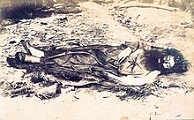
In Sept. 1897 the Canudos War (begun 1896) sees 30K black, Indian, and mestizo settlers in the dry bushland Bahia Province in NE Brazil on the Vaza-Barris River led by bearded Christ-like Antonio Vicente Mendes Maciel ("Anthony the Counselor") (1830-97), who claims to be a prophet heralding the return of Portuguese king Sebastian I (1554-78) and dresses in a blue tunic, straw hat, and leather sandals hold off the Brazilian army for 1 mo. before Maciel dies of dysentery on Sept. 22 and they surrender on Oct. 2, after which they are massacred and raped, the best remaining women sent to brothels, leaving only 150 survivors; 5K escape to shanty towns in large cities?; "At the end of the world, the land will change into sea, and vice-versa." (Maciel)

On May 19, 1906 Joao Franco Ferreira Pinto Castelo Branco (1855-1929) becomes PM #48 of Portugal (until Feb. 4, 1908), ruling with an iron hand as the repub. movement gains steam and blows up in his face?

On Feb. 1, 1908 king (since Oct. 19, 1889) Carlos I (b. 1863) is assassinated in Lisbon along with his son Crown Prince Dom Luis Filipe, and his younger son Dom Manuel becomes Manuel II (the Patriot) (the Unfortunate) (1889-1932), the last king of Portugal (until Oct. 5, 1910).

On Oct. 3-4, 1910 2K soldiers and sailors rebel, resulting on Oct. 5 in the naval Oct. 5 Rev. in Portugal, with the French-style First Portuguese Repub. (ends 1926) proclaimed at 9:00 a.m. from the balcony of the Pacos de Concelho in Lisbon; the monarchy is ended, and king (since Feb. 1, 1908) Manuel II flees to Gibraltar, then goes into exile in England, becoming the last king of Portugal, where he lives with his uncle the Duke of Orleans and plots to return until Portugual enters WWI on the side of the Allies, then lives in England until his death (1932); intellectual-poet Joaquim Teofilo (Teófilo) Fernandes Braga (1843-1924) becomes provisional pres. (until 1911); too bad, the bad economy combined with plots on the left and right keep this new repub. rocking, and it goes through 10 presidents in 16 years.
On Apr. 30, 1911 women gain the right to vote in Portugal.
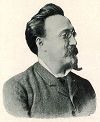
On Aug. 24, 1911 atty. gen. #1 (since Nov. 17, 1910) Manuel Jose (José) de Arriaga Brum da Silveira e Peyrelongue (1840-1917) of the Repub. Party becomes pres. #1 of the First Portuguese Repub. (until May 29, 1915), which promulgates a new liberal 1911 Portuguese Constitution with a bicameral Cortes Gerais (until 1933) - and with a name like that, the ballots must've cost a fortune?
In 1911 in Portugal the monetary unit and gold coin milreis (a thousand reis) is superseded by the escudo.
On Aug. 13, 1913 Britain and Germany begin secret negotiations to create potential spheres of influence in Portugal's African possessions; they are finalized on Oct. 20.


On May 29, 1915 after monarchist revolts led by Capt. Henrique Mitchell de Paiva Cabral Couceiro (1861-1944) (gov.-gen. of Angola in 1907-9) cause Manuel de Arriaga to flee, Teofilo Braga becomes pres. #2 of the 1st Portuguese Repub., but he resigns on Aug. 6 in favor of cause Manuel de Arriaga to flee, Teofilo Braga becomes pres. #2 of the 1st Portuguese Repub., but he resigns on Aug. 6 in favor of Bernardino Luis Machado Guimaraes (Guimarães) (1851-1944), who becomes pres. #3 (until Dec. 12, 1917).
On Mar. 9, 1916 Germany and Portugal declare war on each other; on Mar. 15 Austria-Hungary declares war on Portugal; the first Portuguese troops land in France next Jan., and pres. Bernardino Machado personally visits them - now they're in trouble?
On Aug. 7, 1916 Portugal joins the Allies.
On Oct. 28, 1916 a German U-boat sinks U.S. steamer Lanao off Portugal.
On Feb. 3, 1917 the 50K-man Portuguese Expeditionary Force arrives in France.

In Mar. 1917 the Angel of Peace allegedly first appears to three shepherd children Lucia Santos, Jacinta Marto, and Francisco Marto at the Cova da Iria in Fatima (Fátima), Portugal, followed by the Virgin Mary next May 13, who tells them three secrets, incl. a vision of Hell, and the Virgin's request for the consecration of Russia to prevent it from spreading its errors throughout the world; the last of which was supposed to be revealed in 1960 but is sealed by the Vatican (until ?); on Oct. 13, 1930 Bishop Jose de Silva declares the miracle "worthy of belief", legitimizing the Cult of Our Lady of Fatima; on May 13, 1946 Pope Pius XII grants a canonical coronation to the venerated image in the Chapel of the Apparitions of Fatima; on Nov. 11, 1954 he raises the Sanctuary of Fatima to the status of minor basilica - he's really a she?
On June 17, 1917 the Portuguese Expeditionary Force goes into action for the first time in Flanders.
On Oct. 15-18, 1917 the Germans win the Battle of Mahiwa in German East Africa and begin invading Portuguese East Africa, advancing almost to the mouth of the Zambezi River, then falling back to Lake Nyasa and invading Rhodesia on Nov. 2, 1918 just before the armistice.
On Nov. 25, 1917 after running low at the Battle of Mahiwa, the Battle of Ngomano sees the Germans invade Portuguese East Africa to gain supplies in their manos, allowing them to last out the war.

On Dec. 5, 1917 Portuguese pres. (since Oct. 5, 1915) Bernardino Machado is deposed by a military coup led by math prof. Gen. Sidonio (Sidónio) Bernardino Cardoso da Silva Pais (1872-1918), causing Machado to to into exile on Dec. 12 (until 1919); Pais becomes a dictator, getting himself elected pres. #4 of the 1st Portuguese Repub. on Dec. 27 (until Dec. 14, 1918) and PM #66 on Dec. 12 (until May 9, 1918), becoming known as the "president-king".


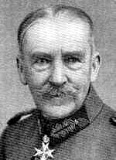
On Apr. 7, 1918 phase two of the German Offensive of 1918 is launched with the Battle of the Lys (Lys Offensive) (Fourth Battle of Ypres) (Third Battle of Flanders) (called Operation Georgette by the Germans after they scale back Operation George) (ends Apr. 29) in the British sector of Armentieres (Armentières) in Nord-Pas-de-Calais, France on the Lys River, with a plan to hit the city with 40K gas shells then overrun the S sector of the Ypres Salient and reach the coast between Calais and Dunkirk, starting with a 4.5-hour bombardment, followed by an attack by 14 divs. on a 10-mi. front, driving the British back, then shelling them with 2K tons of poison gas, incapacitating and blinding 8K, and killing 30K, meeting two Portuguese divs. before being stopped by the British and French on Apr. 29; on Apr. 9 the 2nd Portuguese Div. of 20K men under Gen. Manuel de Oliveira Gomes da Costa (1863-1929) stops 50K Germans (4 divs.) of the Sixth Army under Gen. Alexander Ferdinand Ludolf von Quast (1850-1934), and loses 7K men and 300 officers incl. 6K POWs, creating a 3.5-mi. gap in the British line, but shows the Germans up as pikers in one of their greatest military screwups in history; too bad, the Portuguese pop. sees it as a smashing defeat, causing dictator-pres. (since Dec. 27, 1917) Sidonio Pais (b. 1872) to be assassinated on Dec. 14 at the Rossio Railway Station in Lisbon, and on Dec. 16 marine officer Joao do Canto e Castro da Silva Antunes (1862-1934) becomes pres. #5 of the 1st Portuguese Repub. (until Oct. 5, 1919), immediately facing a repub. rev. in Dec., followed by a monarchist rev. in the N next Jan.

On Jan. 19, 1919 the Kingdom of Traulitania (Portugal) (Monarchy of the North) is set up by monarchist Capt. Henrique Mitchell de Paiva Cabral Couceiro (1861-1944) sans endorsement of deposed Manuel II; it folds by Feb. 13.

On Oct. 5, 1919 pres. (since Dec. 16, 1918) Joao do Canto e Castro is succeeded as pres. #6 of the 1st Portuguese Repub. by Antonio Jose (António José) de Almeida (1866-1929) (until Oct. 5, 1923) (a medically-trained academic who founded Oporto U. and Lisbon U. in 1911), who was elected on Aug. 6 and becomes the only pres. to serve his full 4-year term, trying in vain to steady the rocking boat in Portugal, and visiting Brazil in 1922 on the occasion of its 100th independence anniv. and giving a nice speech.

On Oct. 5, 1923 after being elected in absentia on Aug. 6, pres. (since Oct. 5, 1919) Antonio Jose de Almeida is succeeded by "Maria Adelaide" novelist Manuel Teixeira Gomes (1860-1941) (vice-pres. of the gen. assembly of the League of Nations) of the Liberal Repub. Party as pres. #7 of the First Portuguese Repub. (founded 1910), arriving in Lisbon on Oct. 3 (until Dec. 11, 1925), going on to suppress four major revolts by radicals and the military in 1924-5 while being harassed by the Nationalist Party.
On Dec. 11, 1925 after a campaign of defamation by his PM Antonio Maria da Silva, pres. (since Oct. 5, 1923) Manuel Teixeira Gomes resigns, and former pres. (1915-17) Bernardino Machado is elected pres. #8 of Portugal (until May 31, 1926); Gomes heads for Bougie, Algeria, where he spends the rest of his life, dissing the dictatorship developing back home.




On May 28, 1926 the May 28 Coup in Braga, Portugal led by Gen. Manuel de Oliveira Gomes da Costa (1863-1929) (whose portrait bears a striking resemblance to Don Quixote?) ousts pres. (since 1925) Bernardino Machado, and on May 31 puts in marine officer (Freemason) Jose (José) Mendes Cabecadas Jr. (1883-1965) as pres. #9 of the 1st Portuguese Repub. (until June 19), but after he proves incapable of governing, da Costa becomes pres. #10 on June 29, also proving incapable, and on July 9 Antonio Oscar (António Óscar) (de) Fragoso Carmona (1869-1951) (a Freemason) ousts him in another coup, exiling him to the Azores, where he eventually returns and dies in poverty, becoming pres. #11 of Portugal on Dec. 29 (until Apr. 18, 1951); Portugal remains under either a military or civilian dictatorship with puppet presidents until 1974.
In 1931 the Benguella-Katanga Railroad is completed, becoming tne first trans-African railroad line, running 2,949 mi. from Benguela in Portuguese Mozambique to Beira in Portuguese Angola, and running through the copper ore town of Elisabethville in Belgian Congo.


On July 5, 1932 studious finance minister (since Apr. 28, 1928) Antonio (António) de Oliveira de Salazar (1889-1970) is elected PM #100 of Portugal (until Sept. 25, 1968), becoming a dictator who rules with a strong hand along with his elder protege-pres. Antonio Oscar (António Óscar) (de) Fragoso Carmona (1869-1951), founding the anti-Communist pro-Roman Catholic Estado Novo (New State) (ends 1974), with the motto: "God, Fatherland, and Family", going on to support Gen. Franco in the Spanish Civil War, and stay neutral during WWII; Salazar's doctrine of Pluricontinentalism claims that the Portuguese Empire is not a colonial empire but a single nation-stte spread across the continents.
On July 4, 1937 an assassination attempt on Portuguese dictator Antonio de Oliveira Salazar en route to say Mass at a friend's house in Lisbon fails to kill him, but he starts driving around in an armor-plated Chrysler Imperial; anarchist Emidio Santana is arrested in Britain and returned to Portugal, then sentenced to 16 years in prison.
On May 7, 1940 the Concordat of 1940 is signed in Vatican City by Portugal and the Holy See, limiting Church power in Portugal while throwing them a bone in that canonical marriages are not allowed to obtain a civil divorce, resulting in 91% of all marriages being canonical by 1960.
On June 13, 1940 Pope Pius XII issues the encyclical Saeculo Exeunte, honoring Portugal's 800th anniv., calling for it to modernize missionary work.
On July 6, 1949 a freak heat burst in Figueira da Foz and Coimbraon the C coast of Portugal results in a temp rise of 100.4F to 158 F (38 C to 70 C) in two min. (unconfirmed).


On Apr. 18, 1951 creaky Portuguese dictator pres. (since Dec. 29, 1926) Gen. Antonio de Fragoso Carmona (b. 1869) dies, and his slightly less creaky protege (an economist) Gen. Antonio (António) de Oliveira Salazar (1889-1970), whom he had put in power in 1932 becomes acting pres. of the unhappy military nuthouse; on Aug. 9 young whippersnapper air force marshal Francisco Higino Craveiro Lopes (1894-1964) becomes puppet pres. #12 of Portugal (until Aug. 9, 1958), with Salazar remaining as PM #100 (until Sept. 25, 1968).
On Mar. 11-12, 1959 a coup attempt is discovered in Portugal by several junior officers supported by progressive Roman Catholics.
On Jan. 4, 1960 the European Free Trade Assoc. (EFTA) Convention is signed by the "Outer Seven States", Britain, Denmark, Austria, Portugal, Norway, Sweden, and Switzerland, entering into force on May 3; Finland joins in 1961, and Liechtenstein in 1991; Britain and Denmark leave in 1973, followed by Portugal in 1986; by the end of the cent. only Iceland, Norway, Switzerland, and Liechtenstein remain.

On Feb. 4, 1961 after the Portuguese insist on staying, pissing-off the Communist-led natives, the Portuguese Colonial (Overseas) War (of Liberation) in Angola (ends Apr. 25, 1974) begins with an uprising of Africans in Luanda, led by the Nat. Front for the Liberation of Angola (FNLA), founded on July 14, 1954 as the Union of Peoples of Angola (UPA) by Holden Alvaro (Álvaro) Roberto (1923-2007); on Mar. 13 Adlai E. Stevenson votes against Portuguese policies in Africa in the U.N. Security Council; on Mar. 15 4K-5K Bakongo rebels attack strategic locations in N Angola, killing 1K+ whites and seizing their farms, with Roberto uttering the soundbyte "This time the slaves did not cower"; on Apr. 18 Portugal sends its first military reinforcements to Angola; on Apr. 25 Roberto meets with Pres. Kennedy, causing Ghanaian pres. Kwame Nkrumah to turn him down for aid; on June 9 the U.N. Security Council votes 9-0-2 (France, U.K.) for Resolution 163, affirming U.N. Gen. Assembly Resolution 1603 declaring Angola a non-self-governing territory and calling on Portugal to go along; in Mar. 1962 the UPA merges with the Dem. Party of Angola to form the FNLA, establishing the Rev. Govt. of Angola in Exile (GRAE) in Kinshasa on Mar. 27, with Jonas Savimbi as foreign minister, after which Roberto divorces his wife and marries a woman from the village of the wife of Zairian pres. Mobutu Sese Soko to establish a political alliance; in 1963-9 Israel gives it aid.
On Apr. 13, 1961 there is a failed coup attempt in Portugal against dictator (since 1932) Antonio de Oliveira Salazar when defense minister Botelho Moniz and other military leaders demand his resignation; Moniz is dismissed from his post.
On Dec. 18-19, 1961 Operation Vijay sees Indian troops invade and conquer the Portuguese territories of Goa, Damao, and Diu, in Portuguese possession since 1510, turning them into a territory of India - which did we love more, the shoes or the price?
On Jan. 1, 1962 Portuguese army troops led by Capt. Joao Varela Gomes, along with Roman Catholic dissident militants led by Manuel Serra attack the army barracks in Beja, Portugal.
On Jan. 15, 1962 Portugal walks out of the U.N. Gen. Assembly during a debate on Angola.

In Sept. 1962 Mozambique-born Syracuse U. sociology prof. Eduardo Chivambo Mondlane (1920-69) founds Frente de Libertacao de Mozambique (Mozambique Liberation Front) (FRELIMO) to fight against Portuguese colonial rule, launching the Mozambique War of Independence (ends June 1975); by 1964 it is gathering steam, and by 1966 they control most of the rural N; too bad, he is killed by a book bomb on Feb. 3, 1969 in Dar es Salaam, Tanzania.
On Dec. 3, 1966 the 12-3 Incident (1-2-3 Riot) sees anti-Portuguese demonstrations held in Macau modeled after the Chinese Cultural Rev. turn into a riot, causing a curfew to be declared on Dec. 4.
On Dec. 16, 1966 the U.N. Security Council approves an oil embargo against Rhodesia, and adopts the Internat. Covenant on Economic, Social and Cultural Rights and the Internat. Covenant on Civil and Political Rights; on Dec. 17 South Africa refuses to participate, causing British PM Harold Wilson on Dec. 20 to withdraw all his offers to Rhodesia and announce that he will only agree to independence after a black majority govt. is founded; Portugal also refuses to participate.

On Sept. 21, 1968 Portuguese PM #100 (since July 5, 1932) Antonio de Oliveira Salazar (1889-1970) suffers a stroke, and on Sept. 27 his ultraconservative former deputy (rector of Lisbon U. since 1959) Marcello Jose das Neves Alves Caetano (1906-80) replaces him without his knowledge, becoming PM #101 of Portugal (until Apr. 25, 1974). On July 27, 1970 Antonio de Oliveira Salazar (b. 1889) dies in Lisbon without knowing that he has been supplanted.
On Dec. 16, 1972 the Portuguese army massacres 40 Africans in Tete, Mozambique.






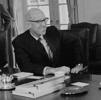
On Apr. 25, 1974 leftist officers in the armed forces led by Maj. Ernesto Augusto de Melo Antunes (1939-) ("an intellectual in uniform"), author of the Document of the Nine (Captains' Manifesto) launch the bloodless (red carnations in their gunbarrels) Captains' (Carnation) (25th of Apr.) Rev. in Portugal, deposing PM (since 1968) Marcelo Caetano (who flees to Brazil), ending 40 years of civilian dictatorship, and forming a Nat. Salvation Junta to supervise the restoration of democracy after 41 years (since 1933); too bad, the April Rev. in Angola reverses Portugal's stand against its independence; on May 15 after the new civilian govt. falls apart, conservative monocled Gen. Antonio Sebastiao (Sebastião) Ribeiro de Spinola (1910-96) (who pub. a critique in Feb. of the dictatorship's African policy, and whom Caetano insisted on surrendering to) becomes provisional pres., going on to abolish the secret police, release political prisoners, promise to restore democracy in Portugal's African colonies, and resume diplomatic relations with Cuba for the 1st time since 1917, pissing-off NATO, who fear that the new govt. will leak secrets; with guerrillas already controlling most of the countryside, Portugal gives up Portuguese Guinea, which on Sept. 10 becomes the Repub. of Guinea-Bissau, with Luis Severino de Almeida Cabral (1931-2009) as pres. #1 on Sept. 24 (until Nov. 14, 1980); Ernesto Melo Antunes is the main megotiator of the independence; on Sept. 15 Spinola meets with Zaire pres. Mobutu Sese Seko on Sal Island, Cape Verde over the future of Angola, and on Sept. 30 he resigns in protest of rushed attempts to dismantle the colonial empire, saying that "a general climate of anarchy" exists; he is succeeded by Gen. Francisco da Costa Gomes (1914-2001) (until July 13, 1976), who is known for fighting liberation movements in Moazambique in 1965-9, but now recognizes decolonization as inevitable; Portugal still has control of Angola, Mozambique, and East Timor; next Mar. Spanish PM Carlos Arias Novarro meets with U.S. deputy state secy. (1974-6) Robert Stephen Ingersoll (1914-2010), and offers to invade Portugal to stop the spread of godless Communism, but Ingersoll is satisfied with Spain remaining non-Communist and allowing the U.S. to keep its military bases there in return for supporting a future NATO membership.
On June 9, 1974 Russia and Portugal reestablish diplomatic ties for the first time since 1917.

On July 13, 1974 Portugal's pres. Antonio de Spinola names army leaders to cabinet posts, incl. Army gen. Vasco dos Santos Goncalves (1922-2005) (ideological leader of the Armed Forces Movement) as PM #103 on July 18 (until Sept. 19, 1975), and vows to bring democracy to Portugal by next spring; Goncalves goes on to suggest the nationalization of banks and insurance cos.



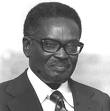

On Jan. 15, 1975 the People's Repub. of Angola, which has been a colony since 1576 is granted independence by Portugal (last Portuguese African colony), and on Nov. 11 it begins nationalizing banking, transport, heavy industries, and the media, and granting the vote to women; under Portuguese pres. Francisco de Costa Gomes it immediately plunges into civil war before promised elections can take place, with the Communist-backed People's Movement for the Liberation of Angola (MPLA) (founded Dec. 10, 1956) and the Nat. Front for the Liberation of Angola (FNLA) (founded July 14, 1954) fighting the CIA and South Africa-backed rebel group UNITA (Union for the Total Independence of Angola) (founded Mar. 13, 1966), led by Jonas Malheiro Savimbi (1934-2002), which secretly invaded in Oct.; on Nov. 11 MPLA leader (and top Angolan poet) Antonio Agostinho Neto (1922-79) becomes Angolan pres. #1 (until Sept. 10, 1979); on Nov. 4 Fidel Castro of Cuba decides to send troops to support the MPLA, and next Jan. the Soviets fly 10 planeloads in, after which 30K Cuban troops are ultimately deployed as the conflict attracts Nicaragua on the Marxist side, and the People's Repub. of China, Israel, Cote d'Ivoire, Zaire, Morocco, and Zambia on the U.S. side.

On Mar. 11, 1975 a right-wing coup attempt in Portugal fails, causing Gen. Antonio de Spinola to flee to Brazil, returning next year after the Nov. 25 coup; in Apr. elections in Portugal brings out 92% of eligible voters (a record for a Western Euro nation), electing gen. Francisco da Costa Gomes as pres., and Adm. Jose Baptista Pinhiero de Azevedo (1917-83) as PM #3, who is sworn-in on Sept. 19 (until June 23, 1976), and loses the pres. election in 1976; the new govt. nationalizes banks, heavy industries, media, and transport, while farm workers in the S expropriate the latifundias and set up communal farms; meanwhile foreign minister (1974 coup leader) Ernesto Melo Antunes visits Pres. Ford in the U.S. and arranges for an $85M emergency aid package; ousted leftist Portuguese PM (since July 18) Gen. Vasco dos Santos Concalves joins the Portuguese Communist Party.

On June 25, 1975 (Wed.) the poverty-stricken People's Repub. of Mozambique becomes an independent state, ending 470 years of Portuguese rule (since 1505), with Samora Moises (Moisés) Machel (1933-86) as pres. #1 (until Oct. 19, 1986); too bad, his govt. embraces Marxism like nearby poverty-stricken Madagascar, after which in 1977 a long civil war begins (ends 1992), ruining much of the wildlife and tourist trade; meanwhile 1M flee Mozambique and other former Portuguese colonies to Portugal, causing strikes and violence.
On Apr. 25, 1976 the 1976 Portuguese Constitution is proclaimed, creating a dual pres.-parliamentary system.


On July 14, 1976 after Socialists win the parliamentary elections in Apr., Gen. Francisco da Costa Gomes is replaced by Gen. Antonio dos Santos Ramalho Eanes (1935-) of the Dem. Renewal Party as pres. #16 of Portugal (until Mar. 9, 1986) (3rd after the Carnation Rev.) after winning 60.8% of the vote; on July 23 Mario Alberto Nobre Lopes Soares (1924-2017) becomes PM (until Aug. 28, 1978) with a weak minority govt., which he makes more unpopular by a strict austerity policy to pay for deficits left by previous govts.

On Mar. 9, 1986 former PM #105 (1983-5) Mario Alberto Nobre Lopes Soares (1924-), a Communist-turned Socialist known for almost single-handedly talking Portugal into joining the EEC becomes pres. #17 of Portugal (until Mar. 9, 1996), and Portugal's first civilian pres. in 60 years; he defeats his opponent by 2% of the votes this time, but by 70% in 1991, pioneering the Presidencia Aberta (open presidency), which features tours around the country addressing a different issue each time.

On Mar. 9, 1996 after defeating Social Dem. Party candidate Anibal Cavaco Silva by 54%-46%, Socialist Party candidate Jorge Fernando Branco de Sampaio (1939-) becomes pres. of Portugal (until Mar. 9, 2006), going on to oversee the transfer of Macao's sovereignty to China in Dec. 1999 and publicly support East Timor's independence.
On May 22-Sept. 30, 1998 (132 days) the Expo '98 world fair is held in Lisbon, Portugal (its first), celebrating the 500th anniv. of Vasco da Gama's discovery of a sea route to India, attracting 11M visitors and costing $2B, and highlighting Europe's largest aquarium with the theme "The Oceans, a Heritage for the Future"; each night flamethrowing cranes move around a giant inflatable egg-shaped globe in a sound and light show.

On Jan. 22, 2006 former PM (1985-95) Anibal Antonio Cavaco Silva (1939-) (a Keynesian economist) wins the election, and on Mar. 9 is sworn-in as pres. #19 of the Portuguese Repub. (until Mar. 9, 2016), becoming the first to enjoy an absolute parliamentary majority and going on to lead Portugal into the EU and have the longest tenure of any Portuguese PM since Salazar.
On Feb. 11, 2007 a Socialist Party-backed abortion referendum in Portugal to legalize abortion up to 10 weeks is approved 59.24%-40.76%, with 43.61% of registered voters voting, which is less than 50%, hence is not legally binding, which doesn't stop Pres. Anibal Cavasco Silva from ratifying it on Apr. 10; future pres. #20 (2016-) Marcelo Rebelo de Sousa leads the opposition.
On Dec. 13, 2007 the Treaty of Lisbon (Reform Treaty) is signed in Lisbon, Portugal, changing the workings of the European Union (EU) to make it more streamlined.
On Mar. 5, 2015 the Madrid Declaration on Developing Energy Interconnections is signed by Spain, France, Portugal, and the EU.
On Nov. 19, 2010 Pres. Obama visits Lisbon, Portugal for a NATO summit, where he discusses Portugal's economic problems with pres. Anibal Cavaco Silva.
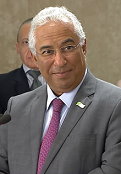
On Nov. 26, 2015 Socialist Party secy.-gen. (since Nov. 22, 2014) Antonio Luis Santos da Costa (1961-) becomes PM #119 of Portugal (until ?).
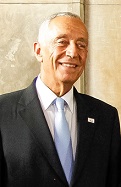
On Mar. 9, 2016 U. of Lisbon law prof. (Roman Catholic) (Independent) Marcelo Nuno Duarte Rebelo de Sousa (1948-) (godson of last Portuguese dictator Marcelo Caetano) becomes pres. #20 of Portugal (until ?).
On Sept. 23-Oct. 15, 2018 Category 1 (90 mph) Hurricane Leslie arises in the N Atlantic Ocean, merging with a frontal system on Sept. 25 and intensifying over the N Atlantic, becoming the strongest cyclone to hit the Iberian Peninsula since 1842, killing 1 in Portugal and 13 in France.